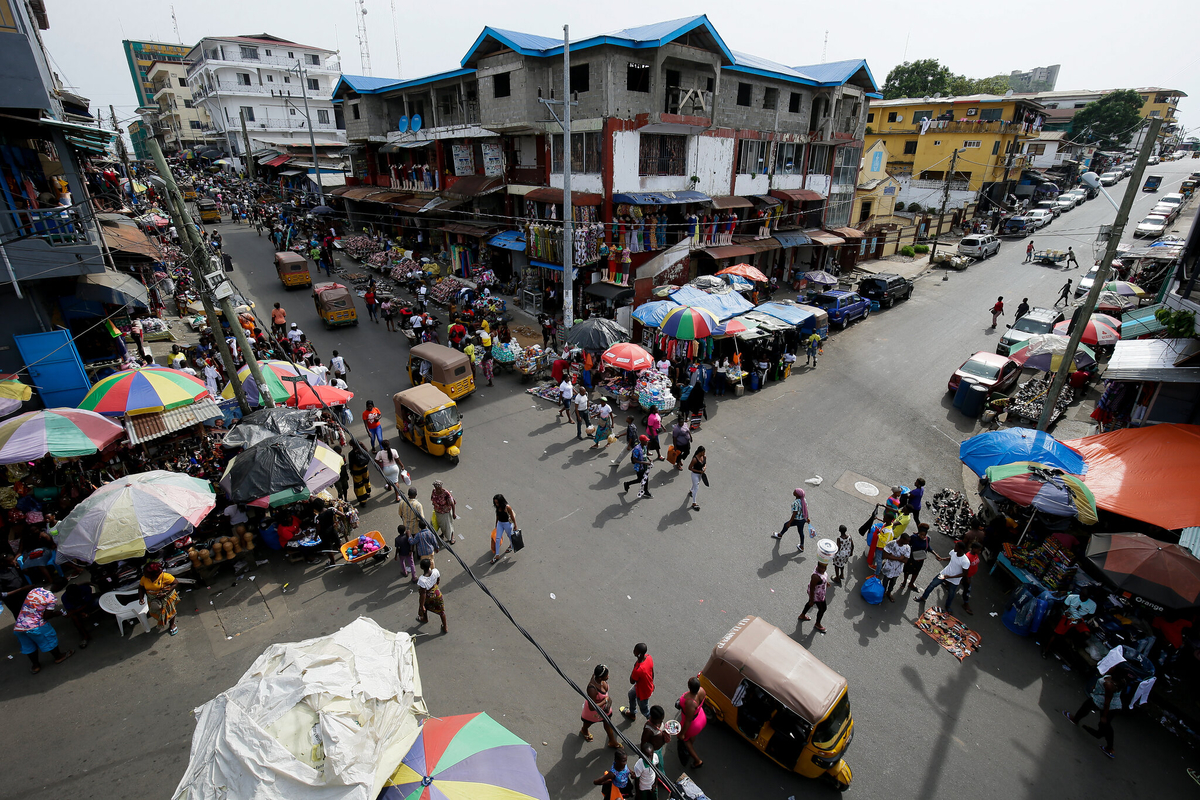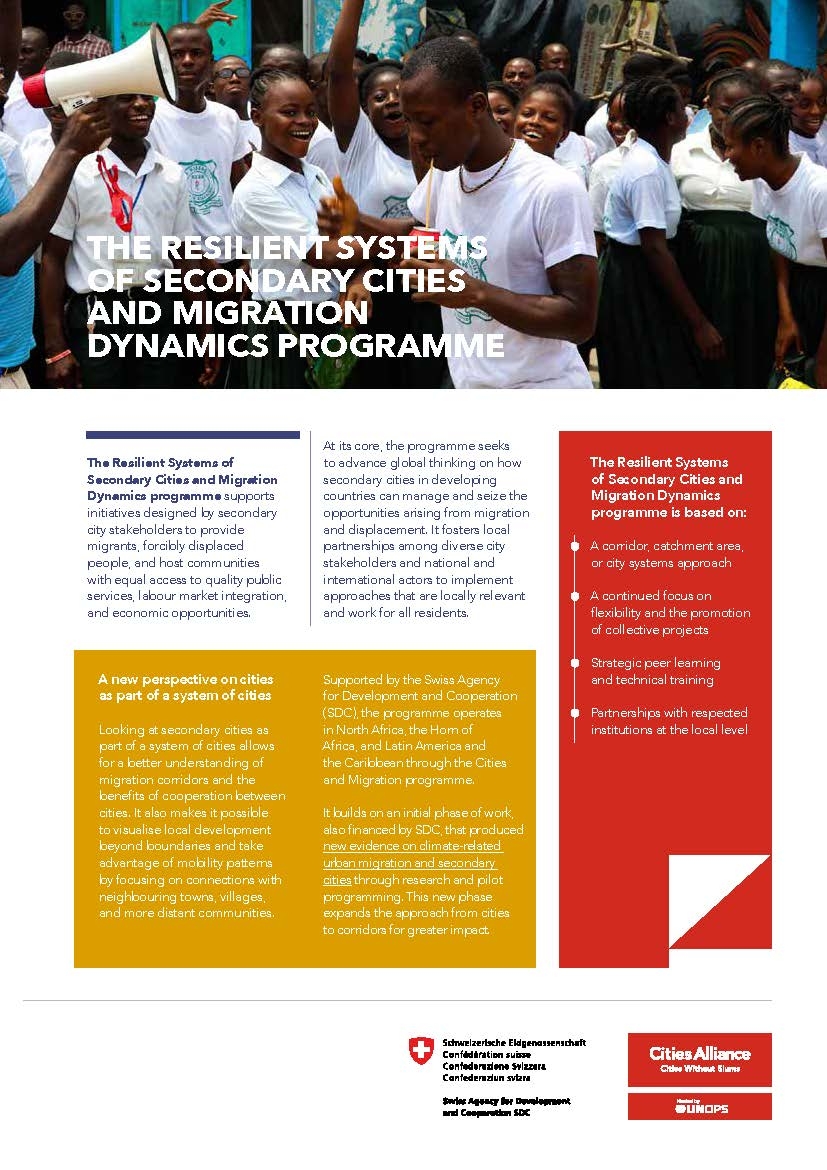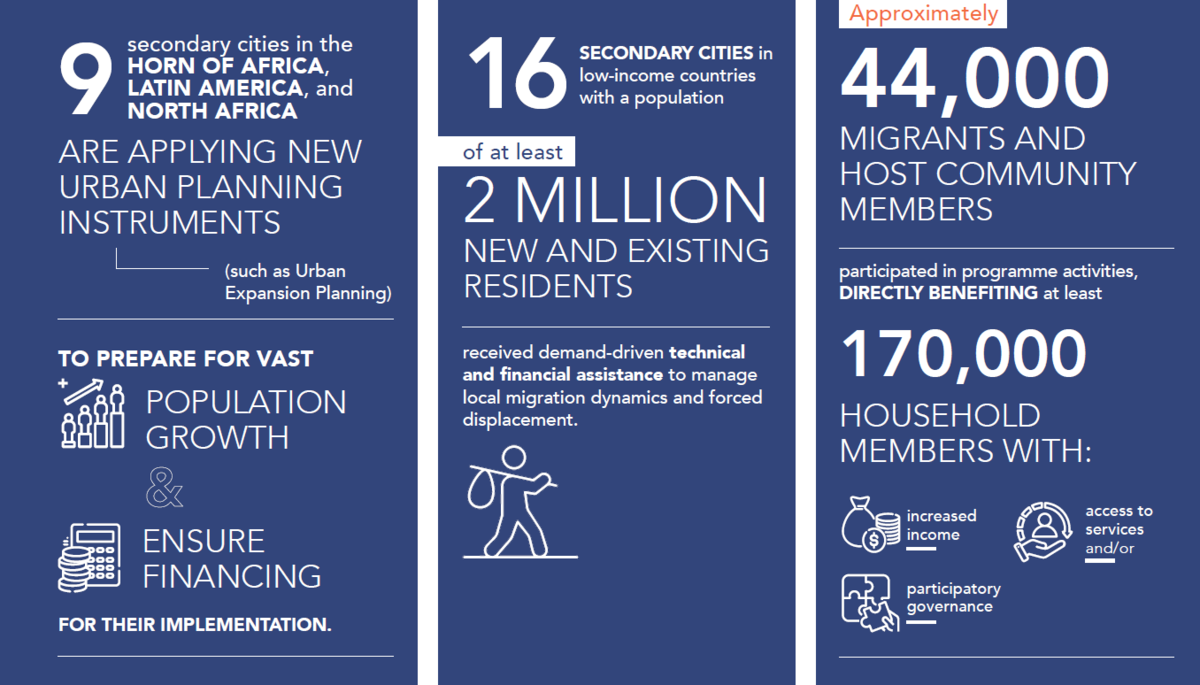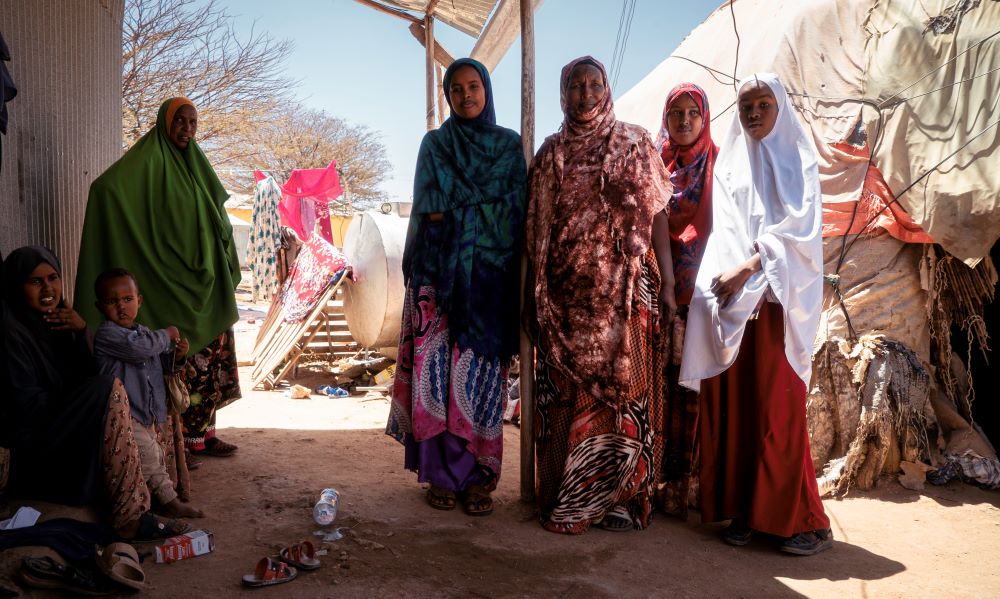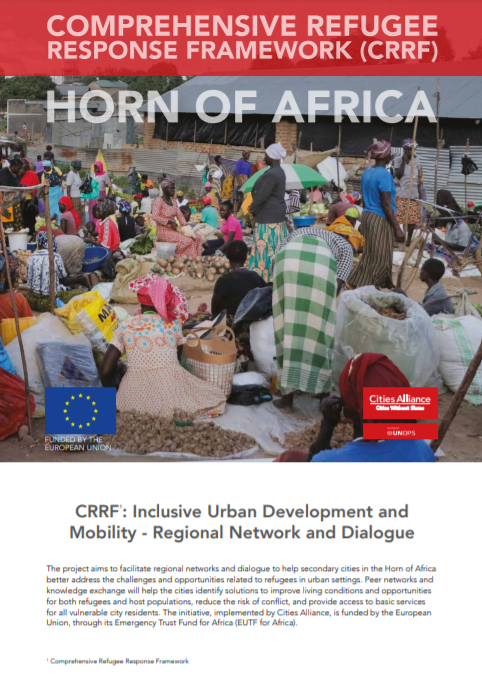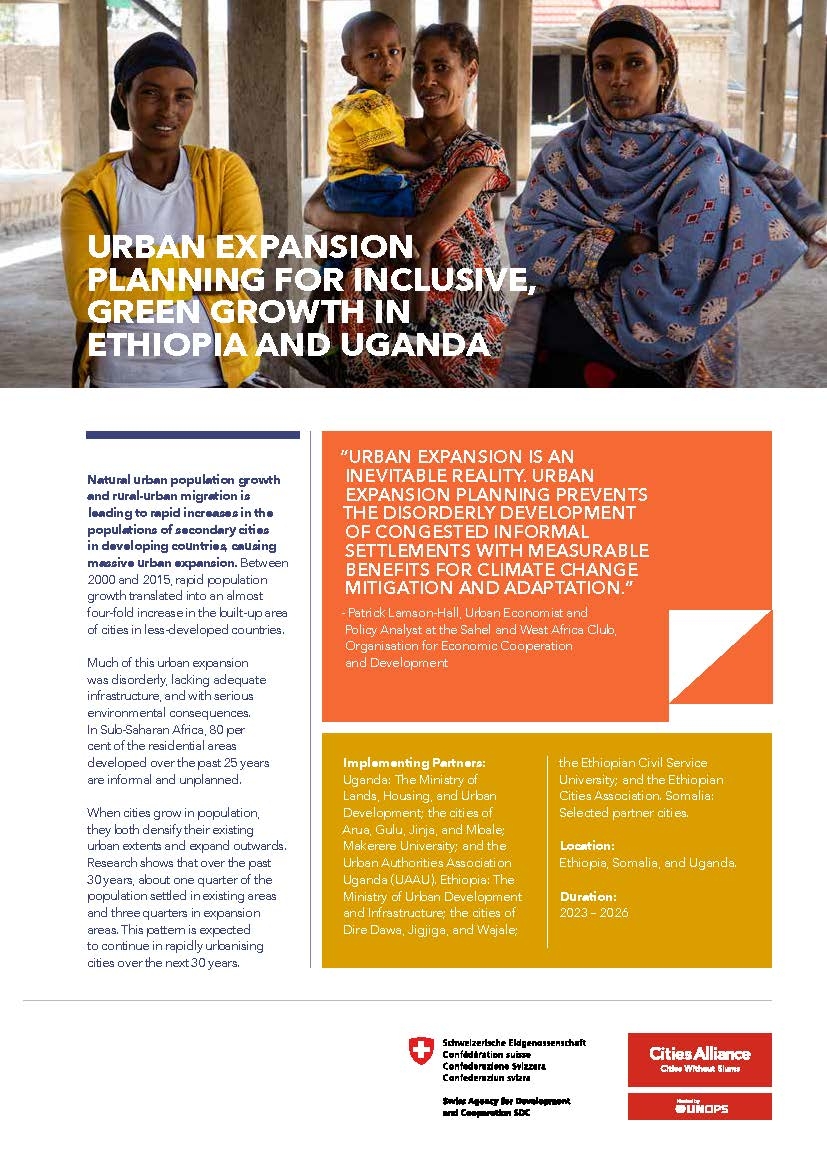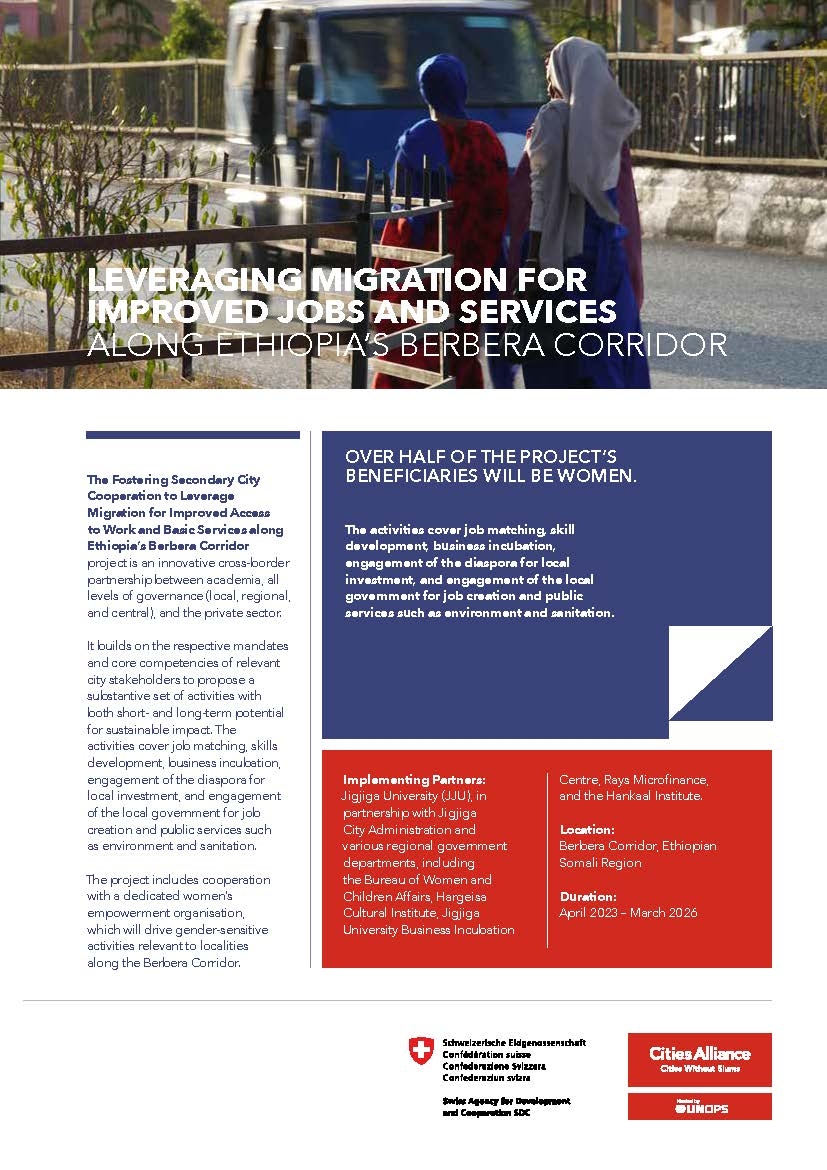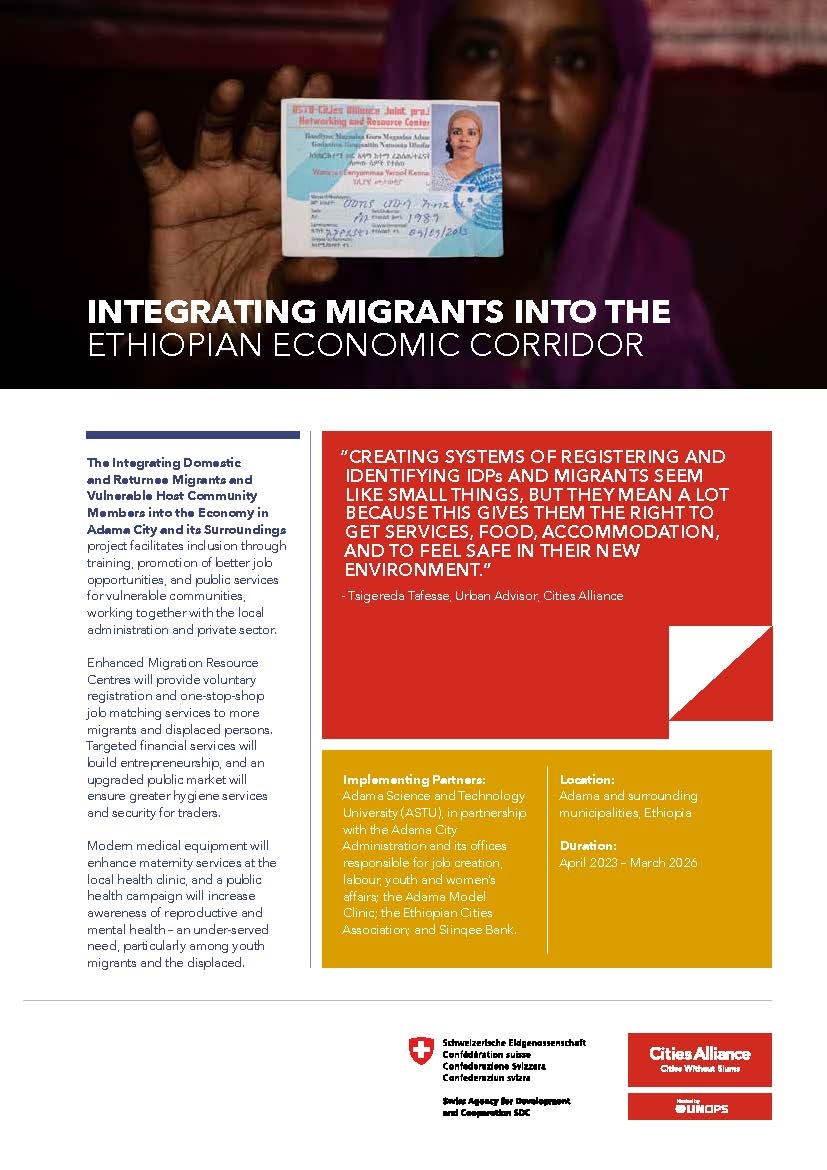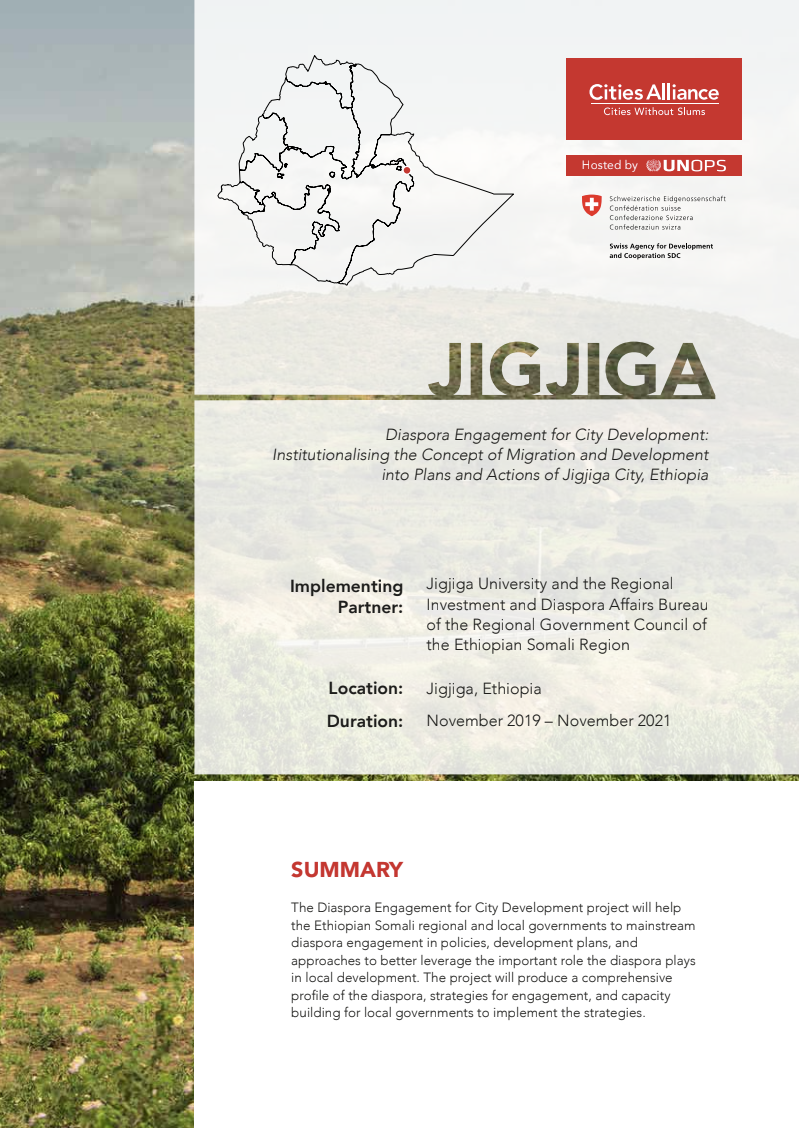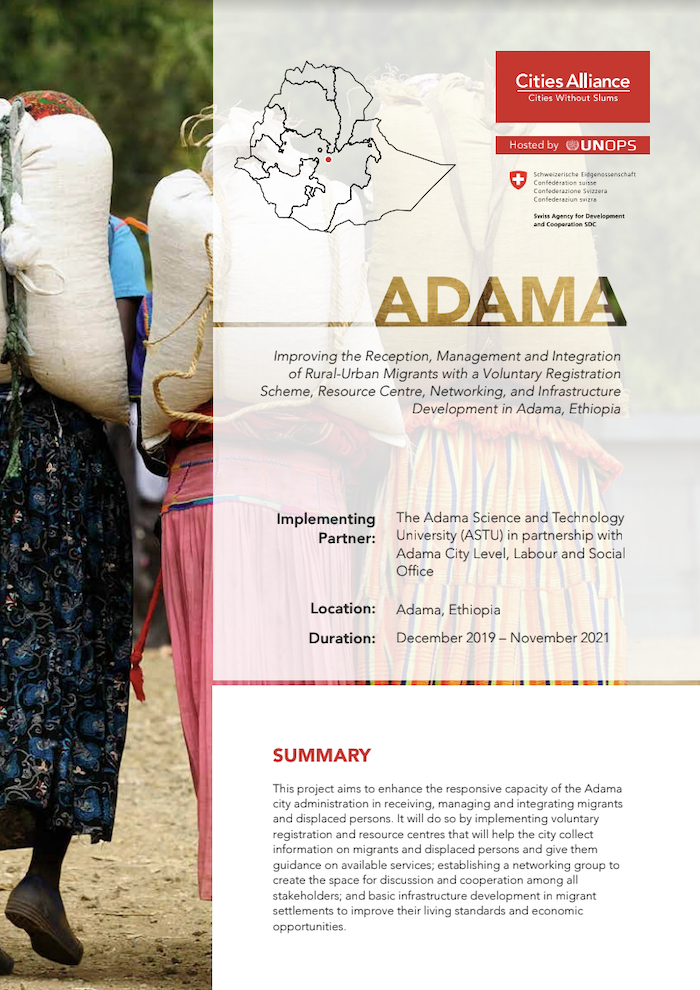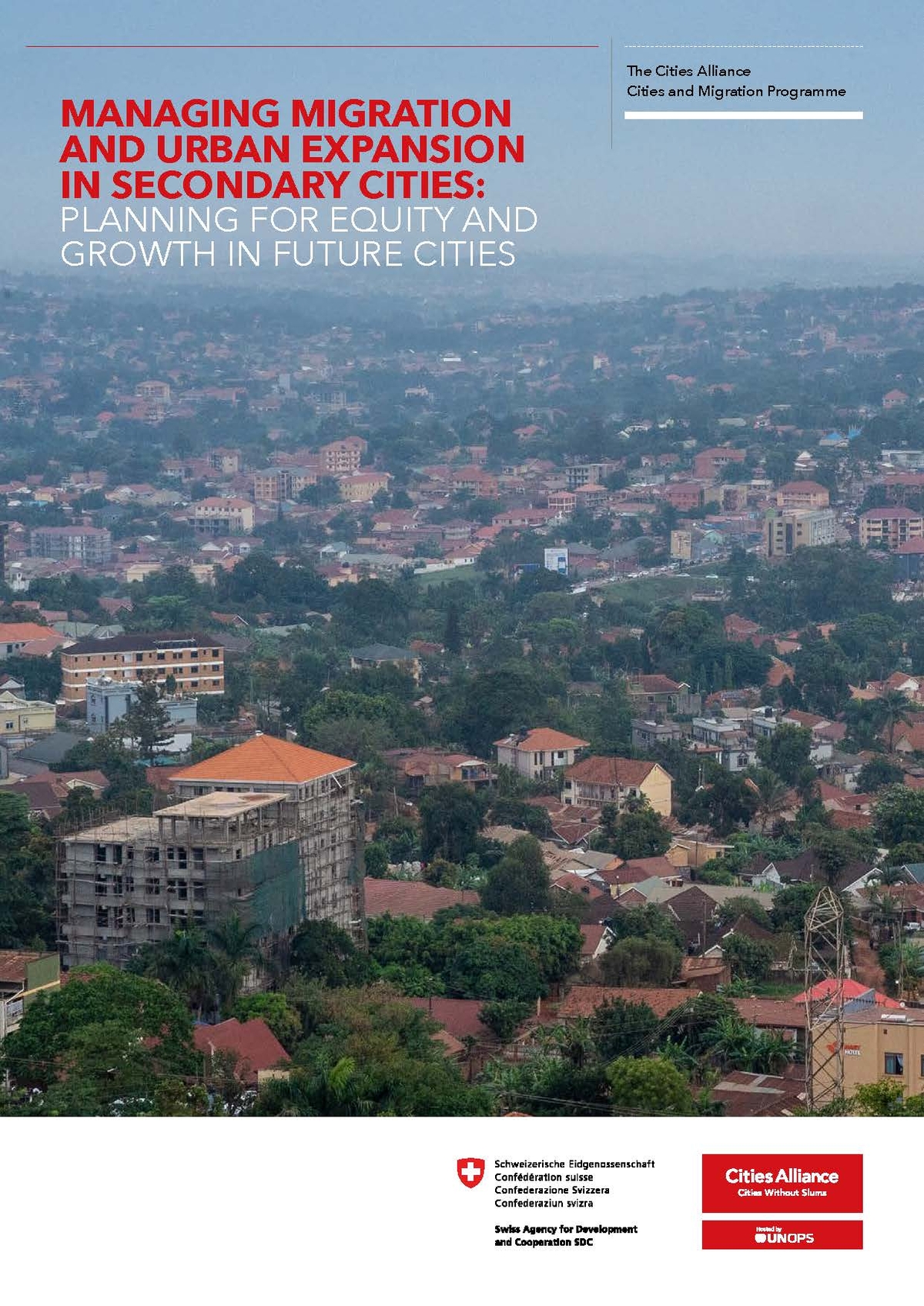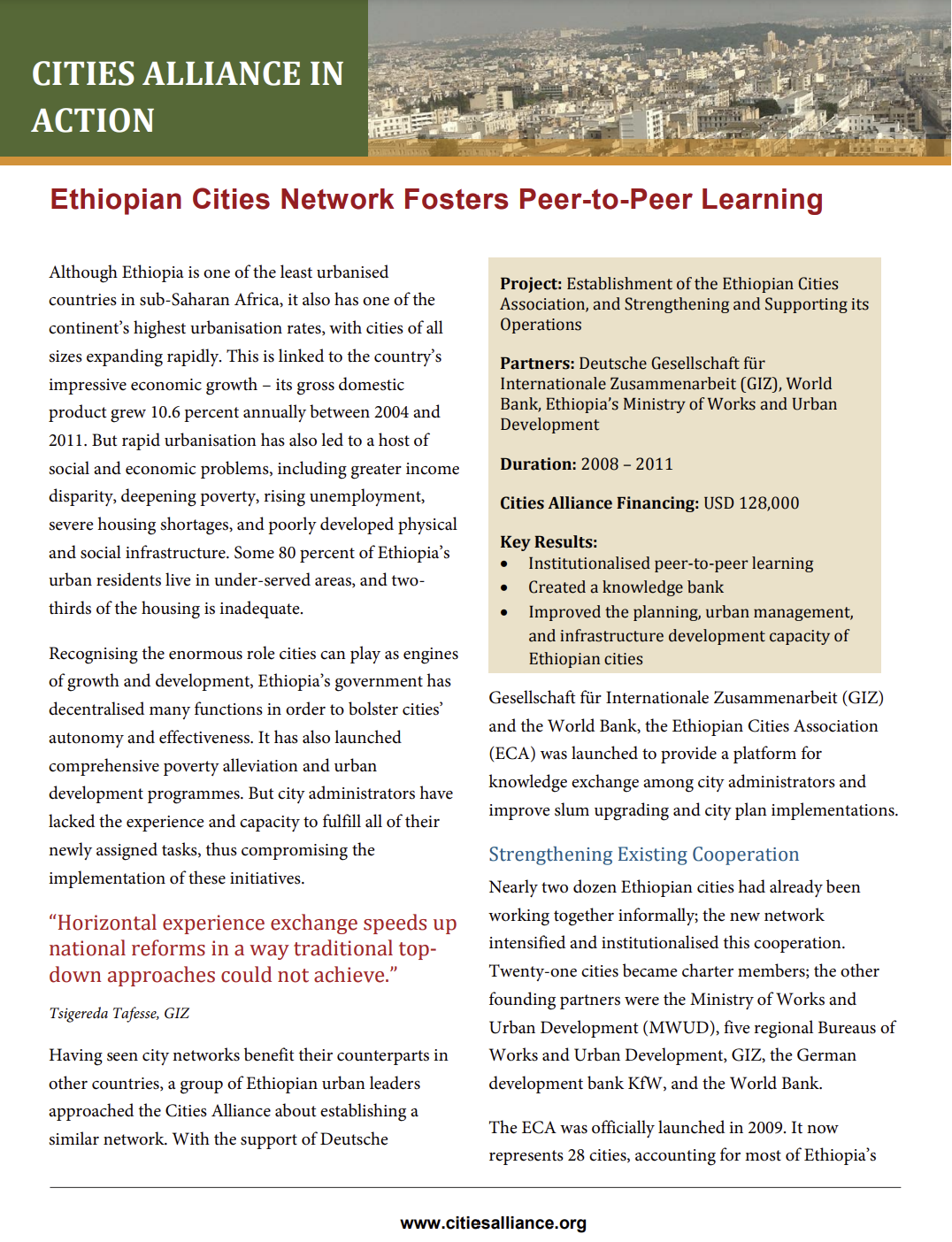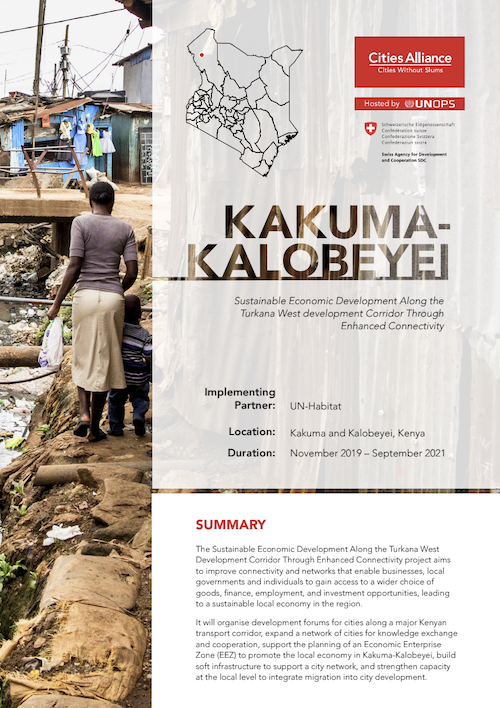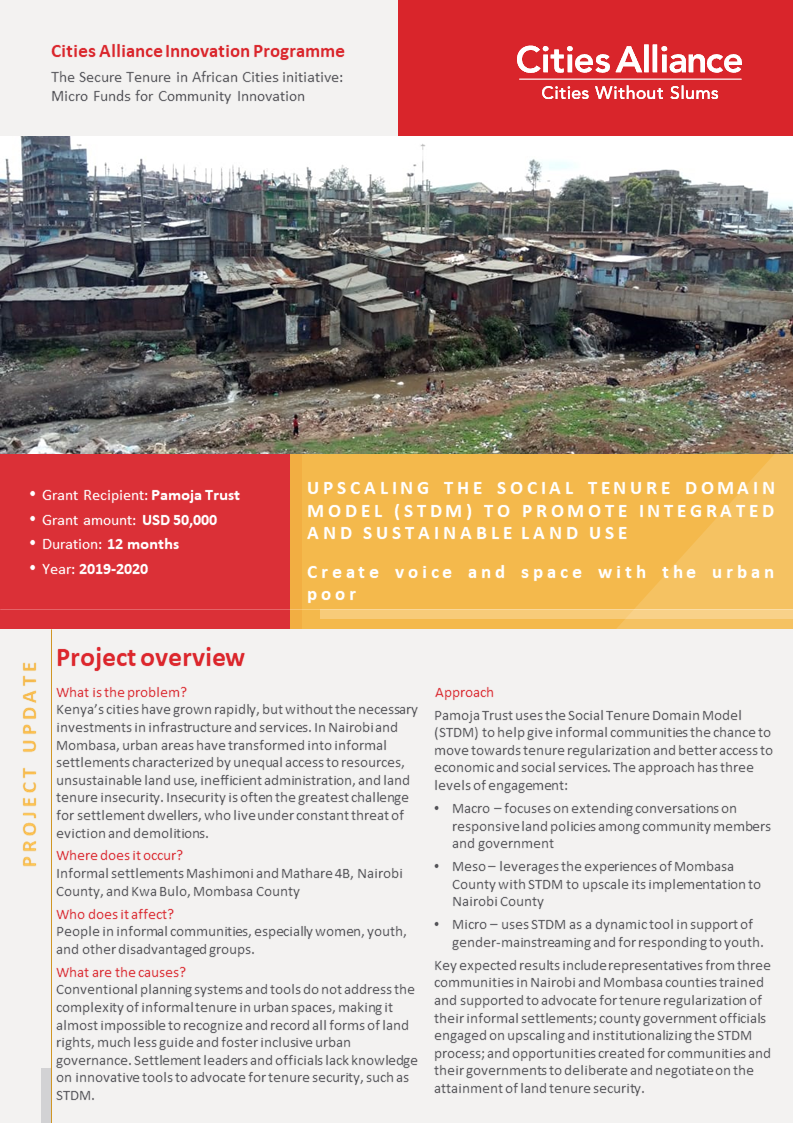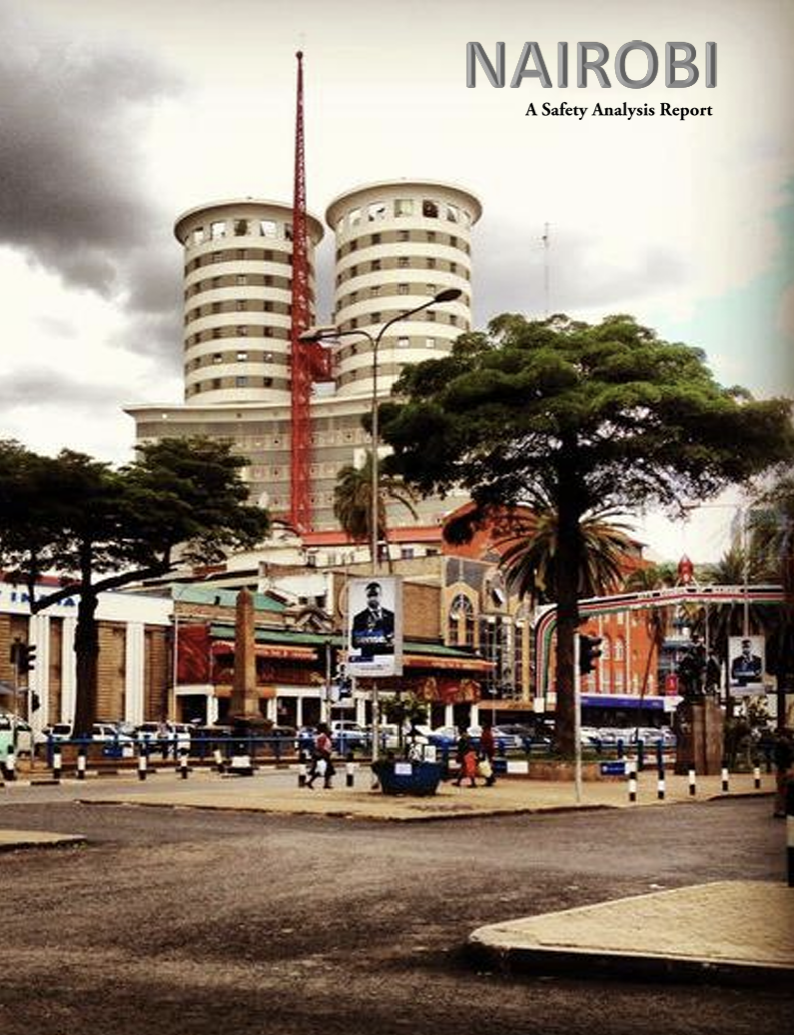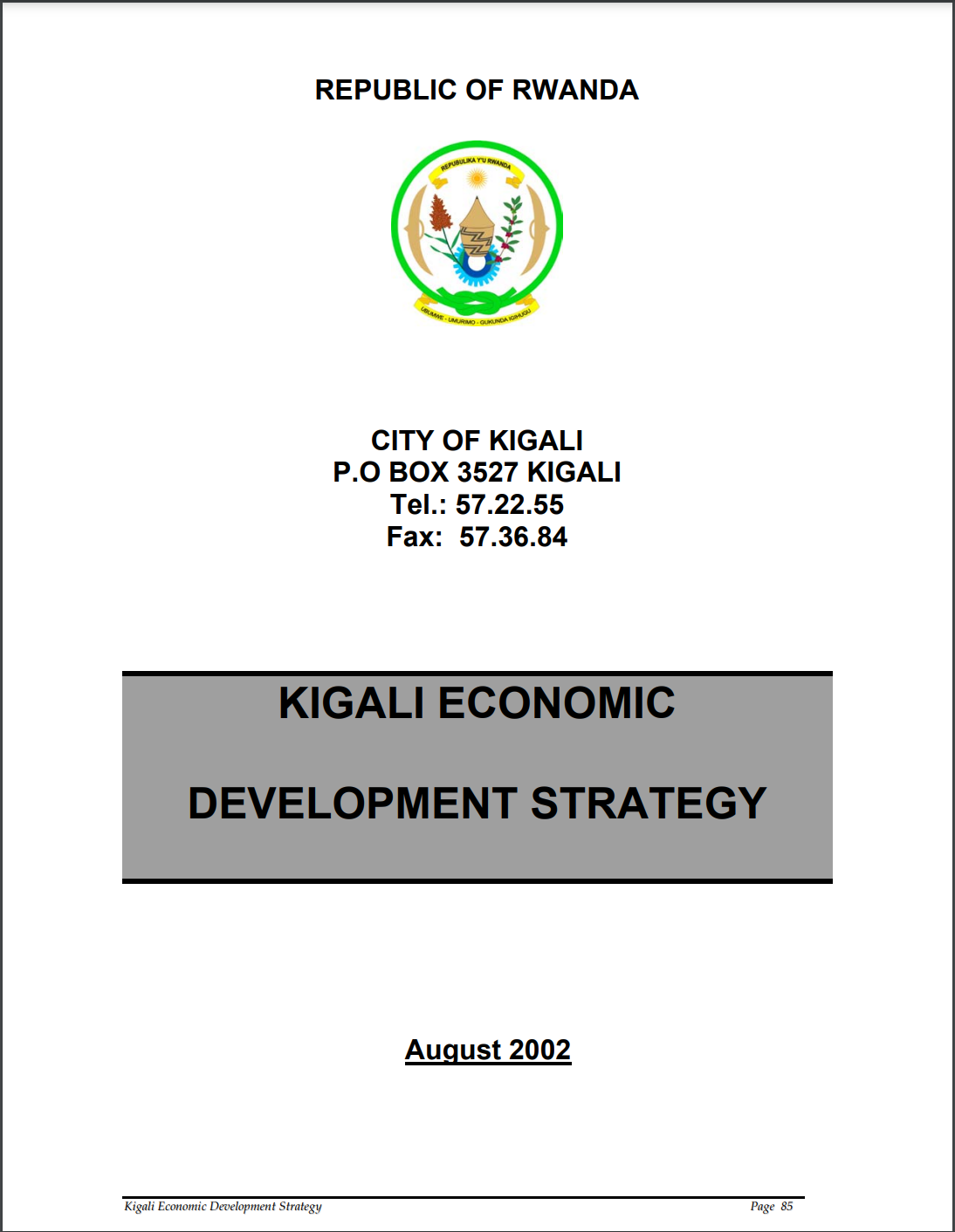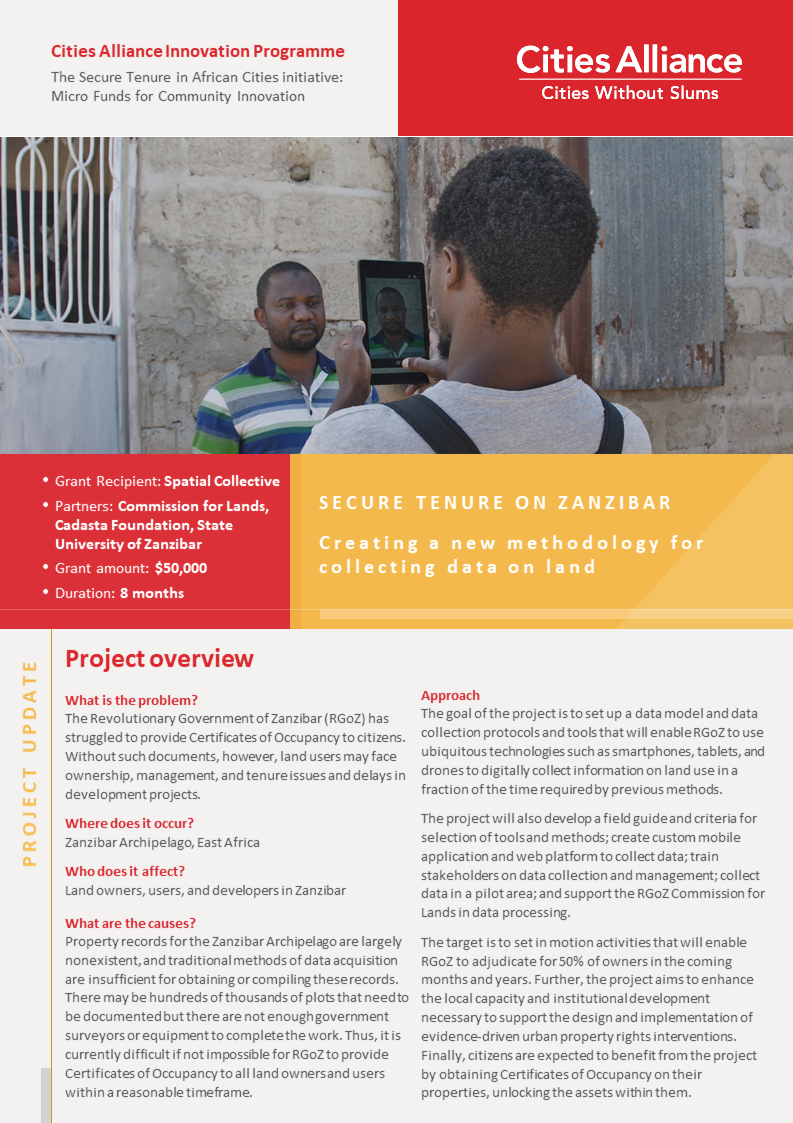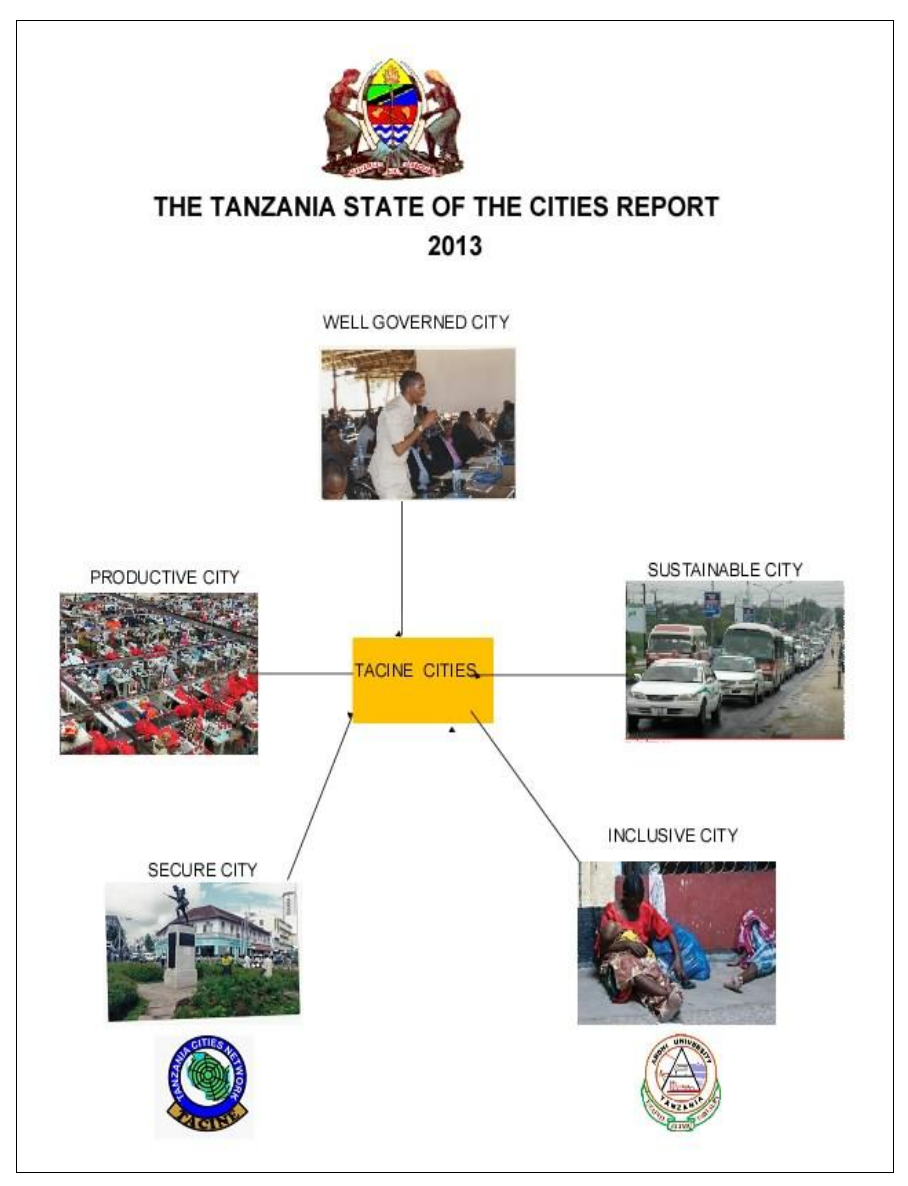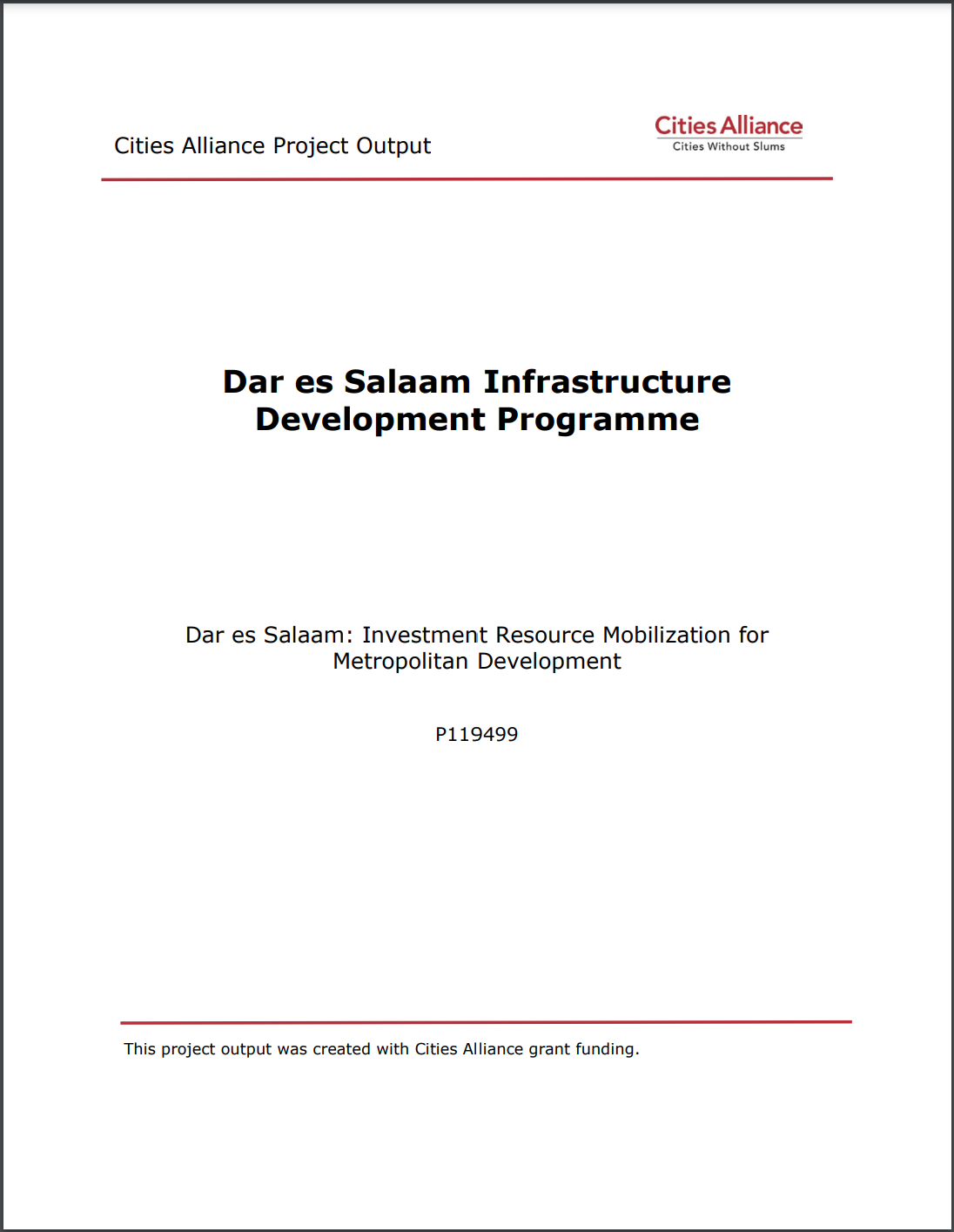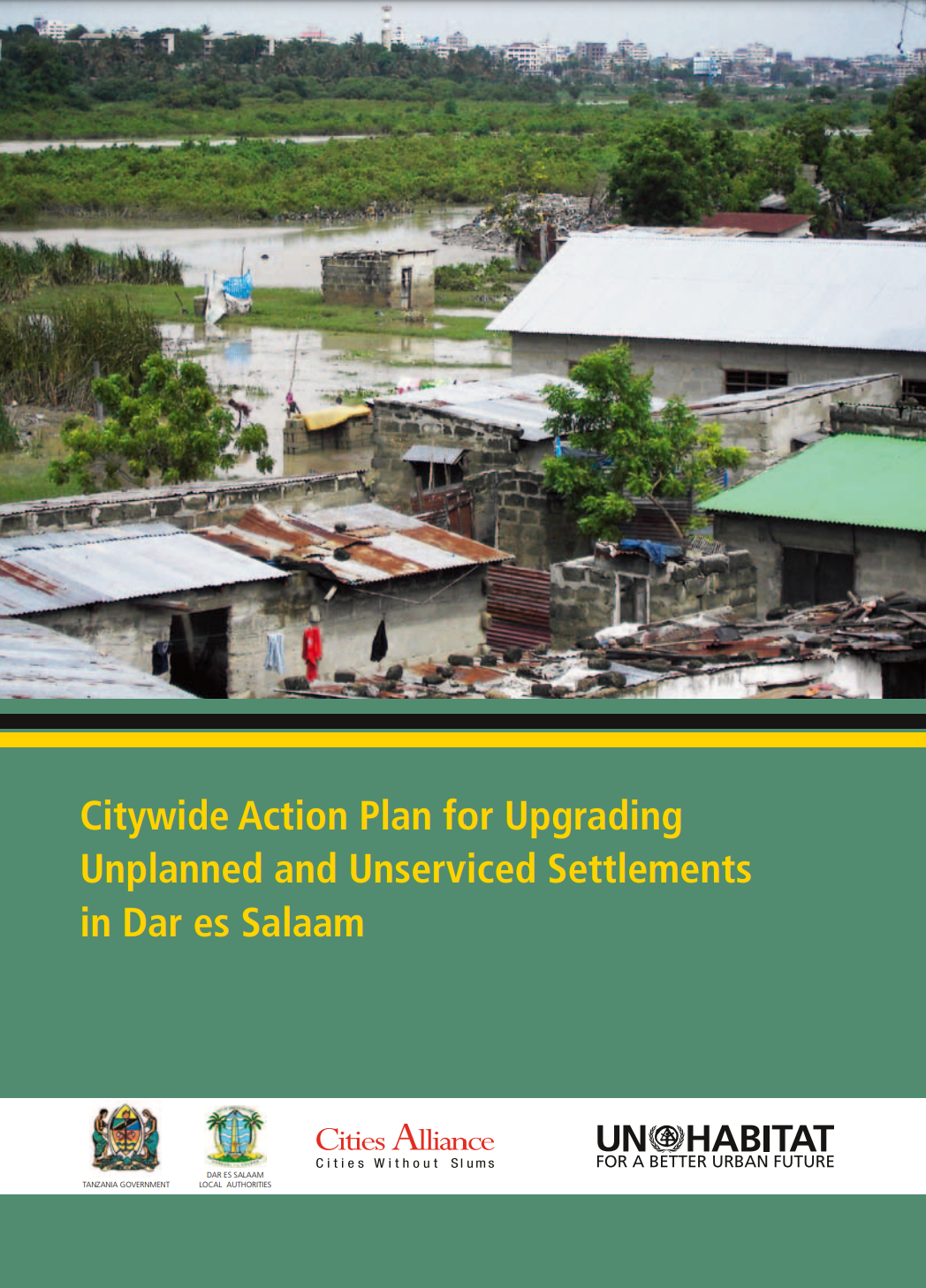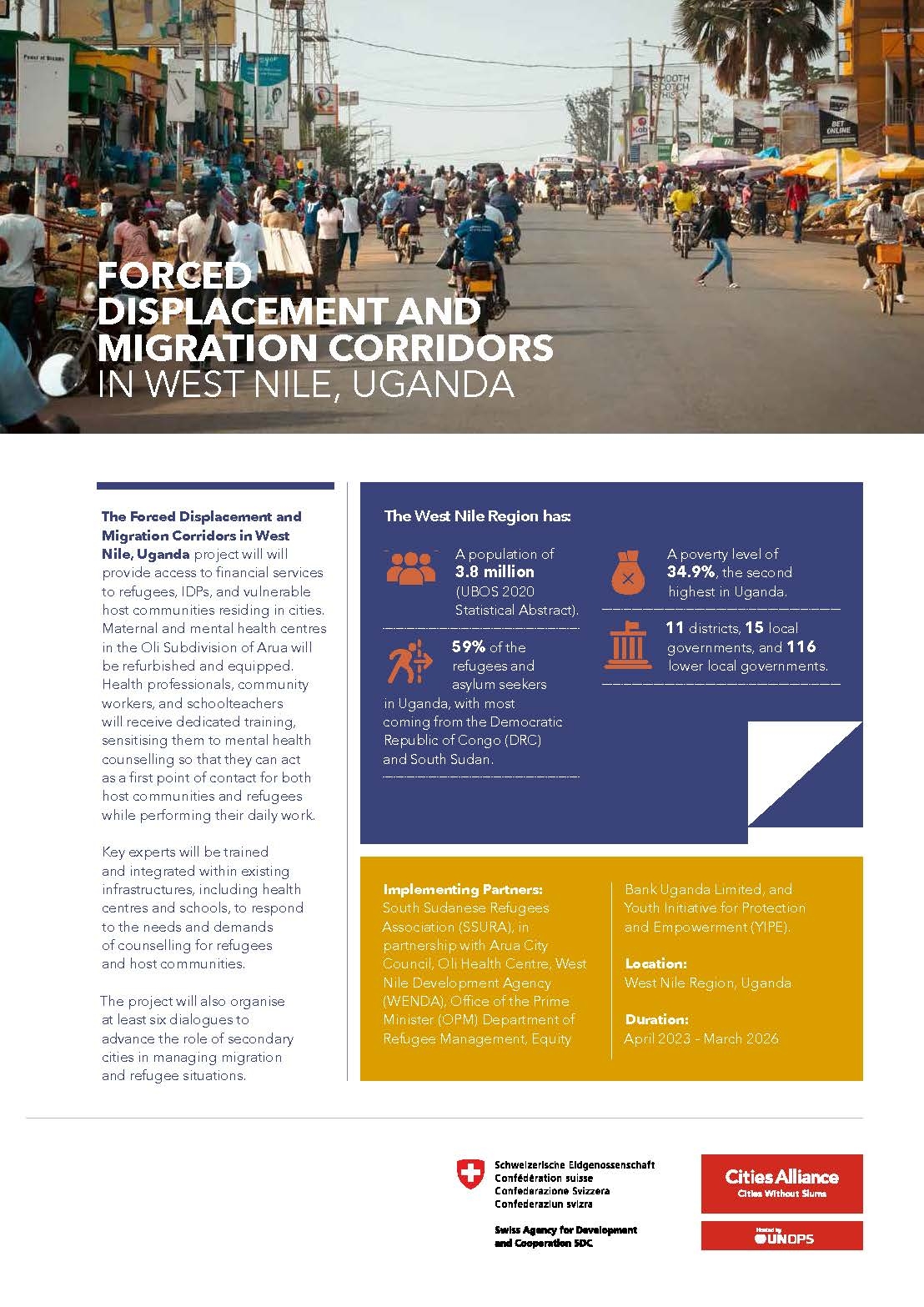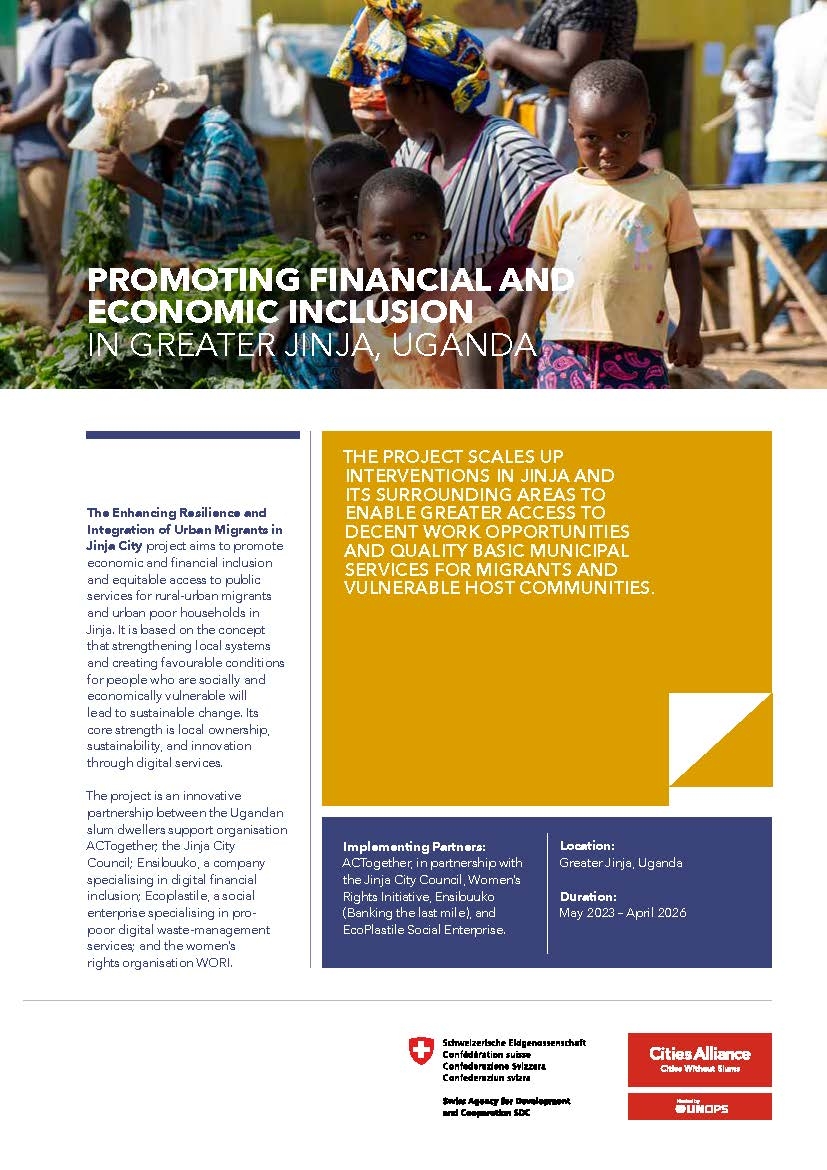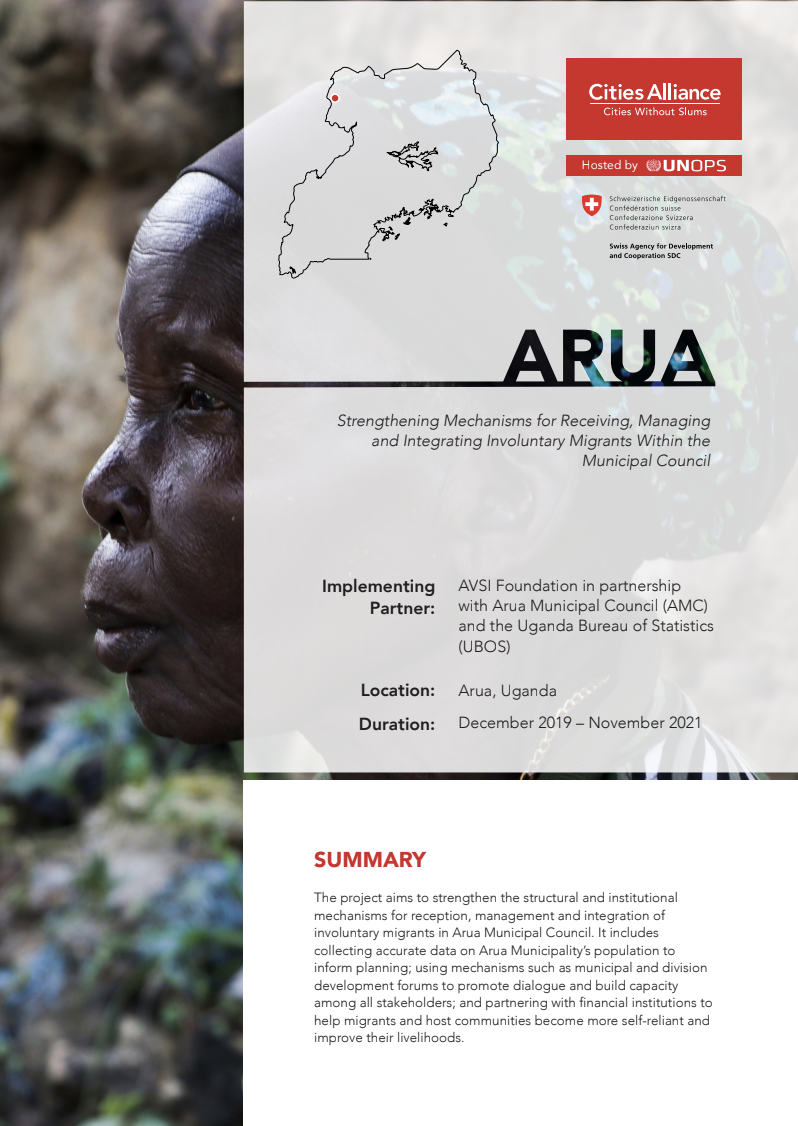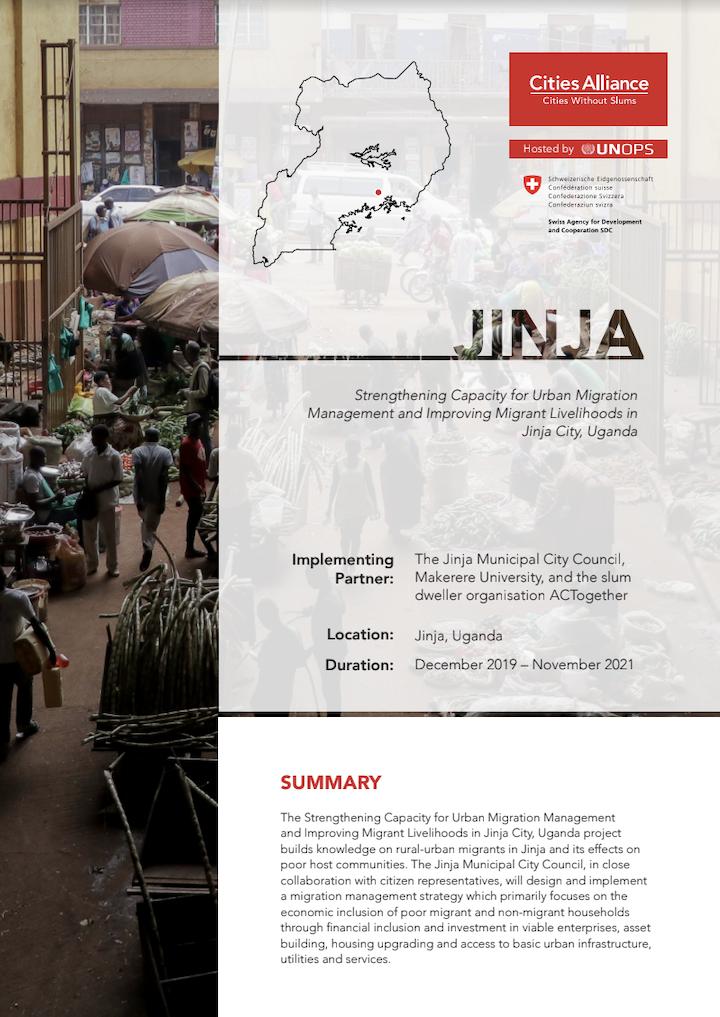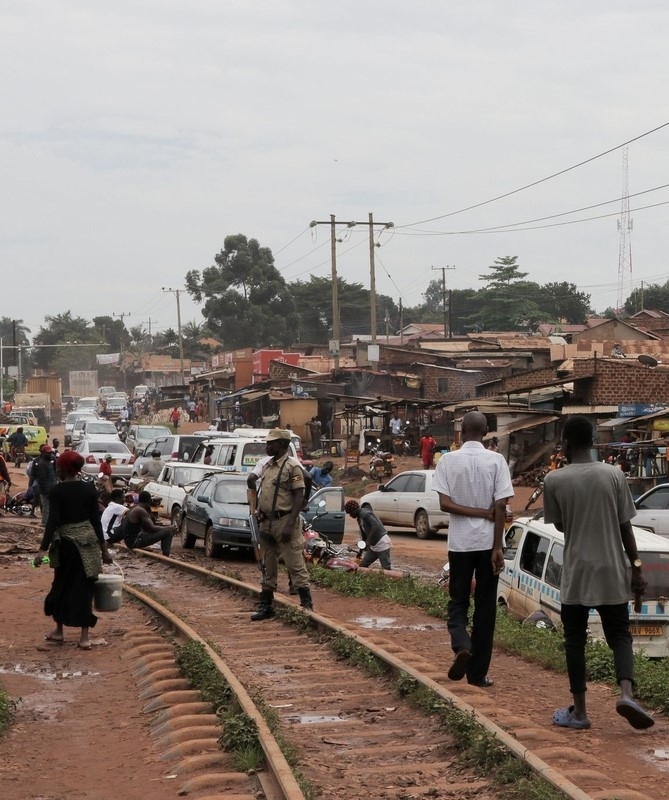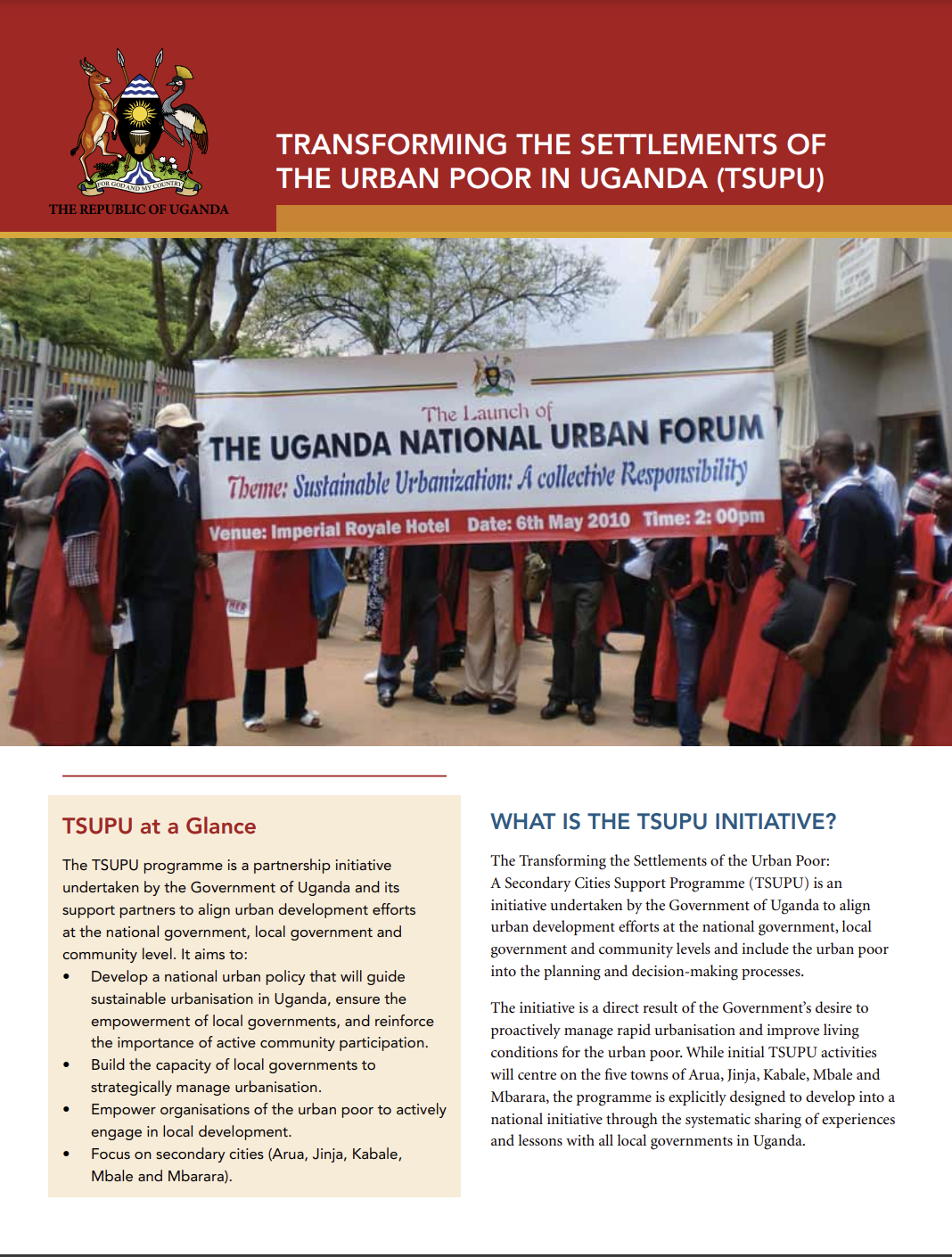Cities Alliance has a strong history of innovation in Eastern Africa. Projects include our first Country Programme in Uganda, piloting Urban Expansion Planning in Ethiopia, city mentorships, city development strategies, and activities to enumerate informal settlements.
A partnership initiative between Cities Alliance and the Swiss Agency for Development and Cooperation (SDC), now in its second phase, is empowering secondary cities to become central actors and leaders in unlocking the development potential of migration.
A second programme funded by the European Trust Fund for Africa (EUTF) is supporting secondary cities to address the refugee crisis in the Horn of Africa by facilitating dialogues towards the integration of refugees and internally displaced persons (IDPs), urban planning, and service provision improvement.
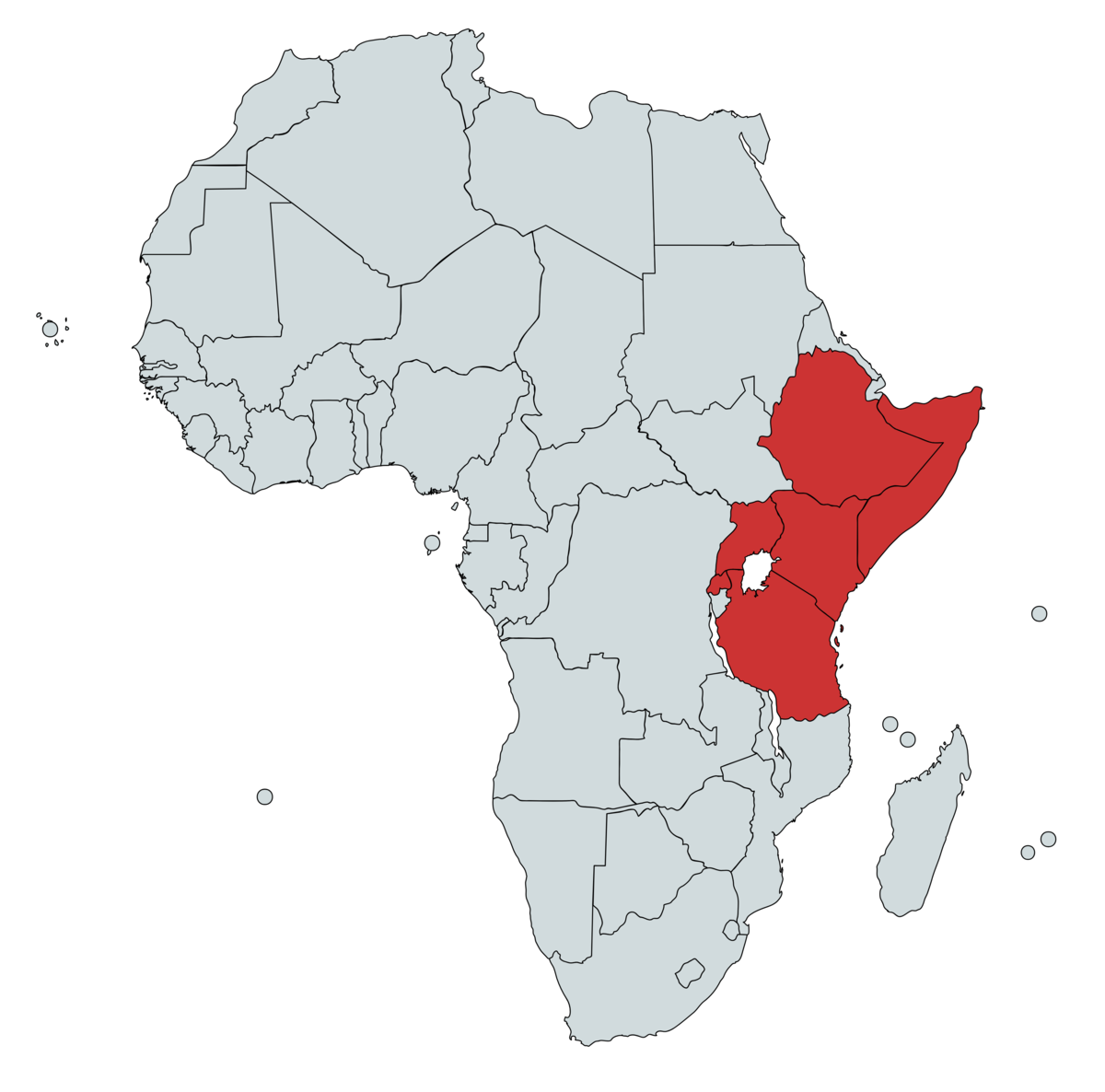
This partnership initiative between Cities Alliance and the Swiss Agency for Development and Cooperation (SDC), now in its second phase, is empowering secondary cities to become central actors and leaders in unlocking the development potential of migration.
It supports initiatives designed by secondary city stakeholders in three regions – the Horn of Africa, Latin America and the Caribbean, and the Middle East and North Africa – to provide migrants, forcibly displaced people, and host communities with equal access to quality public services, labour market integration, and economic opportunities.
In 2024, the programme expanded to Asia with the Urban Mekong Corridor Initiative.
At its core, the programme seeks to advance global thinking on how secondary cities in developing countries can manage and seize the opportunities arising from migration and displacement. It fosters local partnerships among diverse city stakeholders and national and international actors to implement approaches that are locally relevant and work for all residents.
The programme (2022-2026) is funded by SDC, with Cities Alliance providing technical and financial assistance to local partners and governments.
Cities Alliance and the Swiss Agency for Development and Cooperation (SDC) are collaborating on a multi-phase initiative aimed at enabling partner cities, local governments, host communities, and migrants to manage challenges and leverage opportunities arising from migration to cities for sustainable and inclusive development.
The first phase of the programme ran from 2018 to 2021. It provided technical support to nine secondary cities in the Horn of Africa, North Africa, and Latin America. The goal was to help urban leaders understand and address local migration management, with women as the main beneficiaries.
It also produced new evidence on migration in secondary cities, organised regional peer learning events, and provided partner cities opportunities to amplify their concerns at global migration-related events.
This four-year partnership programme aims to foster the sustainable integration of displaced populations and their host communities in secondary cities across Sub-Saharan Africa.
The initiative enhances municipalities' capacity to effectively address the needs of Displacement Affected Communities (DACs) amidst increasing urban challenges caused by forced displacement and migration. At the same time, the host cities and key local stakeholders become more resilient and better prepared for the impacts of human mobility.
SUIDAC seeks to benefit DACs by expanding basic public services, enhancing economic opportunities, and providing better protection. On the city side, SUIDAC will foster multi-level policy dialogue (local, national and regional) on urban forced displacement issues concerning DAC-hosting cities AND strengthen governments' evidence-based responses to these issues.
SUIDAC is active in nine cities in five countries: Democratic Republic of the Congo (DRC), Ethiopia, Somalia, Sudan, and Uganda.
SUIDAC is funded by the European Union with a €30 million grant and implemented by Cities Alliance.
The Comprehensive Refugee Response Framework (CRRF): Inclusive Urban Development and Mobility Action (2021–2023) responded to the unprecedented refugee situation in the Horn of Africa. Funded by the European Union Trust Fund for Africa, it supported secondary cities to integrate refugees and IDPs, plan for urbanisation, and improve basic services.
The cities were Arua and Koboko in Uganda, Kakuma-Kalobeyei in Kenya, Assosa and Jigjiga in Ethiopia, and Gabiley and Borama in Somaliland.
The Action’s activities centred on establishing a regional network and dialogue as well as pilot projects in Koboko and Assosa.
At the city level, the Action created concrete improvements in the lives of refugees, fostered inclusive participation, and provided a means for leveraging additional funding.
A regional network is helping the participating cities share experiences, strengthen policy development for greater social cohesion, and pilot approaches to refugee management and integration. To build the network, the Action organised five peer-learning events to include displaced and vulnerable host communities in urban policy discussions. Through the events, the cities developed the tools and knowledge to continue building the network.
On an international level, the Action helped improve the implementation of global agendas locally, highlighting the role of secondary cities in managing migration, and providing a model for other cities to replicate. Cities of the Action were encouraged to participate in regional and global events.
Five technical reports were published and disseminated along with five workshop reports, a compendium of best practices, and a network strategy.
Natural urban population growth and rural-urban migration is leading to rapid increases in the populations of secondary cities in developing countries, causing massive urban expansion.
Urban Expansion Planning is a simple, cost-effective way for cities to change the trajectory of their rapid growth in an inclusive and environmentally sustainable manner.
The alternative is what secondary cities already witness and reject in their congested and polluted capital cities, with most residents caught in underserved informal settlements.
This project (2023–2026) focuses on regulatory changes to embed Urban Expansion Planning in national policies, as well as creating local service providers to respond to a steady demand from cities for the services of trained practitioners.
It will also support a knowledge hub at leading urban planning institutions in both Uganda and Ethiopia to act as national centres of excellence.
The project is part of the Resilient Systems of Secondary Cities and Migration Dynamics Programme financed by the Swiss Agency for International Development and Cooperation (SDC).
Ethiopia
The Ethiopian Somali Region and its capital, Jigjiga City, have experienced significant economic growth thanks to the social and financial capital investments by the Somali diaspora and returnees. Somaliland and its capital, Hargeisa, have seen a diaspora-led economic boom as well.
Both areas are also experiencing significant migration influxes, often induced by climate change. These rural-to-urban labour migrants, internally displaced persons (IDPs), and refugees suffer from poverty and exclusion, with women and girls disproportionately affected.
Thus, a key challenge for regional and local authorities is making economic growth more equitable, with more migrants and vulnerable host community members benefiting from increasing economic opportunities and services.
This project (April 2023 to March 2026) is an innovative cross-border partnership between academia, all levels of governance (local, regional, and central), and the private sector. It builds on the respective mandates and core competencies of relevant city stakeholders to propose a substantive set of activities with both short- and long-term potential for sustainable impact.
Today, only 22% of Ethiopia’s population lives in cities. This low urban population share, combined with population and strong overall economic growth, may lead to rapid migration flows and urbanisation over the next decade.
One area likely to be especially impacted is the Ethiopian Economic Corridor, which runs from the city of Adama – capital of the Oromia Region – through the towns of Bishoftu, Dukem and Modjo. Adama is especially challenged to absorb migrants and displaced persons, and city authorities are struggling to provide adequate services.
This project (April 2023 – March 2026) facilitates inclusion through training, promotion of better job opportunities, and public services for vulnerable communities, working together with the local administration and private sector.
Partners include Adama Science and Technology University (ASTU); the Adama City Administration and its offices responsible for job creation, labour, youth and women’s affairs; the Adama Model Clinic; the Ethiopian Cities Association; and Siinqee Bank.
The Diaspora Engagement for City Development project (2019–2021) helped the Ethiopian Somali regional and local governments to mainstream diaspora engagement in policies, development plans, and approaches to better leverage the important role the diaspora plays in local development.
The project produced a comprehensive profile of the
diaspora, strategies for engagement, and capacity building for local governments to implement the strategies.
It formed the basis for the Leveraging Migration for Improved Jobs and Services along Ethiopia's Berbera Corridor project.
This project (2019–2021) enhanced the responsive capacity of the Adama City Administration in receiving, managing, and integrating migrants and displaced persons through:
- Resource centres where migrants could receive adequate care services when they arrived in the city. The voluntary registration process also provided valuable information to the city administration and helped it plan more effectively.
- Networking groups that provided space for local stakeholders – including migrants and displaced persons, the city administration and the urban ministry – to discuss the main challenges and opportunities of migration in Adama.
- Improved public infrastructure to provide migrants and displaced persons with better living conditions and economic opportunities, including two new market centres and a healthcare facility.
It was implemented by the Adama Science and Technology University (ASTU) in partnership with Adama City Level, Labour and Social Office with funding from SDC.
The project was the basis for the Integrating Migrants into the Ethiopian Economic Corridor project (2023–2026).
This project (2014–2016) was designed in response to Ethiopia’s forward-planning urban development strategy, aimed at providing land and infrastructure to their growing population in a planned, sustainable, and economically coherent manner.
It was conceptualised and implemented in support of the government of Ethiopia’s five-year Growth and Transformation Plan, specifically in support of the Ministry of Urban Development and Housing in fulfilling its mandate to provide serviced urban land for effective urban growth.
The main output of the project was the development and validation of local development plans (LDP) including detailed macroblock plans, arterial grid layouts, cost estimates, and financing/implementation plans for four Ethiopian cities. These plans have been developed in the cities of Adama, Bahir Dar, Hawassa, and Mekelle and validated by the respective regional state governments.
The plans were developed by city teams in consultation with the local population including those residing in informal settlements. With the LDPs in place, the city boundaries are now clearly defined, and the spatial growth trajectory is well planned to match the projected demographics and to prevent environmental degradation.
The project has strengthened the planning capacities of targeted cities by setting up local planning teams and mobilising international land management expertise to work directly with the city governments in designing, installing, and operating comprehensive, modern planning and land management systems.
This strengthening of planning capacities has been rendered more sustainable through partnership with the Ethiopian Civil Service University (ECSU) which has included a course programme on the urban expansion methodology in its curriculum and expanded the course programme to four regional universities.
Having seen city networks benefit their counterparts in other countries, a group of Ethiopian urban leaders approached the Cities Alliance about establishing a similar network. With the support of Deutsche Gesellschaft für Internationale Zusammenarbeit (GIZ) and the World Bank, the Ethiopian Cities Association (ECA) was launched to provide a platform for knowledge exchange among city administrators and improve slum upgrading and city plan implementations.
The ECA officially launched in 2009 with 21 charter members. As of 2023, it comprises 86 cities, accounting for most of Ethiopia’s major and secondary urban centres. It is overseen by a board of directors (elected by the mayors of partner cities) and managed by a secretariat.
Aside from knowledge sharing, it has focused on providing technical assistance and establishing cooperative relationships with other international networks.
The ECA benefitted greatly from the informal cooperation that was already taking place among certain cities; building on such a base has been an effective way to ensure a more sustainable network. The commitment and contribution of member cities has also been vital: Ethiopian cities drove the establishment of the ECA and continue to have strong ownership of it.
The new network alleviated some of the burden on national and regional governments by enabling cities to implement reforms faster and more effectively. The ECA’s documentation and knowledge exchange activities helped the country overcome challenges posed by high staff turnover.
This project focused on the post-construction management of neighbourhoods built under the Ethiopian government’s Integrated Housing Development Programme (IHDP). It was a part of the Innovation Programme's inaugural Call for Proposals in 2011.
In 2006, the Government of Ethiopia launched the IHDP as part of a broader urban development policy to deliver affordable housing to poor and middle-income residents and create jobs. The programme was implemented in 56 towns across the country, building some 208,000 housing units to date. Approximately half of the total production was concentrated in Addis Ababa, which houses around 25 percent of the Ethiopia’s urban population.
A notable feature of the housing programme was that it created some 176,000 jobs. The labour-intensive delivery method made limited use of machinery and included the production of cobblestone roads.
Working through GIZ, the Cities Alliance provided technical assistance support for the programme. The Cities Alliance grant to the Ministry of Construction and Urban Development helped establish a legal framework for management of the condominiums as well as a set of procedures for the cooperative management of the housing stock, and associated social relations.
This project (2010–2014) supported the development of a national strategy for establishing an integrated urban information database as well as a system for collecting, organising, and making available up-to-date and accurate information on urban development at the city, regional, and Federal government levels.
Implemented by the Ministry of Urban Development and Construction, the project utilised capacities created at the local level by an ongoing GIZ urban governance project operating in a number of Ethiopian cities.
Up-to-date data helped the government better understand the impact of its programmes and monitor urban trends. The database also became a key tool to empower communities, decision-makers, and practitioners to make informed planning decisions.
In 2004, the Cities Alliance and the World Bank Institute supported a partnership between the cities of Johannesburg and Addis Ababa that focused on capacity building and knowledge sharing.
The exchange centred around key areas for cooperation, such as strategic city planning, HIV-Aids programmes, performance management of local governments, and financial development.
While the initiative ended in 2005 following a change in leadership in Ethiopia, it showed that two cities with varying resources can learn effectively from each other. It also laid the foundation for a very successful partnership programme between Johannesburg and the Lilongwe City Assembly, which resulted in the design and implementation of a Lilongwe City Development Strategy.
This project (2002–2004) aimed to reduce and prevent urban poverty in Addis Ababa. It sought to strengthen the transition towards a market economy by ensuring the poor’s participation in urban development, planning, and implementation and by ensuring their rights to housing, services, and land.
The project piggybacked on a master plan undertaken by the city with support from GIZ. It produced a citywide strategic plan for Addis Ababa, defined roles and responsibilities for the city government on housing and urban development issues, participatory local development plans, preparation of a plan for a 10-year financing strategy, and a plan for upgrading tertiary markets. These outputs became working documents that were used and assisted the city government.
Kenya
The Sustainable Economic Development Along the Turkana West Development Corridor Through Enhanced Connectivity project improved connectivity and networks that enabled businesses, local governments, and individuals to gain access to a wider choice of goods, finance, employment, and investment opportunities, leading to a sustainable local economy in the region.
It organised development forums for cities along a major Kenyan transport corridor, expanded a network of cities for knowledge exchange and cooperation, supported the planning of an Economic Enterprise Zone (EEZ) to promote the local economy in Kakuma-Kalobeyei, built soft infrastructure to support a city network, and strengthened capacity at the local level to integrate migration into city development.
The Future Yetu (Our Future) project of the Hope Raisers organisation implemented a series of innovative and creative measures to help the residents of Korogocho better understand and adapt to climate change impacts.
The project is supported by Cities Alliance through the Stronger Partnerships: Local Innovations for New Climate Realities in Cities initiative in partnership with the Swedish Development Cooperation Agency (Sida) and the German Federal Ministry of Economic Cooperation and Development (BMZ).
Korogocho is one of the largest informal settlements in Nairobi, with a population of more than 150,000 people pressed into 1.5 km2. Its location next to the Dandora dumpsite between two tributaries of the Nairobi River leaves this community especially vulnerable to climate-related disasters, as well as hazards such as air pollution and outbreaks of disease. Yet even though communities may be dealing with the impacts of climate change in their lives, the issue can still seem remote.
The project began with a baseline survey to gauge awareness, vulnerabilities, and risks and to prioritise the community's concerns. From the issues identified in the survey, the Future Yetu team developed an innovative, multi-faceted approach that combines the creative arts, digital tools, peer-to-peer outreach, community participation, and enhanced communications with local government.
Conventional tools for city planning, administration, and land management are not designed to address complex questions involving land rights, tenure security, and other issues in the fast-growing informal settlements of Africa's large cities.
To fill this gap, Pamoja Trust, a Kenyan non-profit organization that seeks to promote access to land, shelter, and basic services for the urban poor, has introduced more effective planning tools and approaches that are already yielding results in Mombasa and Nairobi, Kenya.
Pamoja Trust has been using STDM to better understand land tenure relationships and claims in Kenya. With support from the Cities Alliance Innovation Programme,
it has advocated for the scale-up and institutionalization of the innovative Social Tenure Domain Model (STDM), a pro-poor land information management system as part of a project to help residents in the informal settlements of Mashimoni and Mathare 4B in Nairobi County, and Kwa Bulo in Mombasa County plan for a more secure future.
This activity (2015-2017) supported the undertaking of safety audits in Bogotá, Delhi, and Nairobi. It expands the use of SafetiPin, a mobile app that collects detailed information about safety in cities using technology and crowd-sourcing. Through the app, residents can identify and become aware of problem areas.
In each city, analysed data in the form of reports and maps with recommendations were shared with the relevant stakeholders, such as municipalities, transport and lighting departments, and the police. SafetiPin has helped create strong partnerships with local authorities, and its data is currently used as a resource for prioritising municipal infrastructure investments.
In Bogota, the data was shared with several departments to correlate and overlay GIS layers. In Nairobi, it was an opportunity to build the capacity of the local government on using maps and GIS technology. The data also provided all three city authorities with evidence for making decisions on public space improvement.
In Delhi and Nairobi, specific data collection, analysis, and public meetings were conducted in low-income settings to ensure that the digital divide did not leave out certain people. In all cities, the safety audit measured the presence of women on the streets.
Safetipin won the Dubai International Award for Best Practices and the Womanity Award, which recognises initiatives that protect women and girls around the world from gender violence.
Safetipin was funded through the Cities Alliance Innovation Programme's Know Your City Call for Proposals. Read an article about Safetipin
Rwanda and Somalia
The Kigali Economic Development Strategy (KEDS) and its Action Plan project (2000-2002) supported the city of Kigali in undertaking a participatory economic assessment and strategy development process, including a vision and city profile.
The strategy and plan were prepared with the consultation of stakeholders including representatives of civil society, the business sector, local and national government, international and national NGOs, the World Bank, and USAID.
The project represented the first time that the residents of Kigali worked together with the local government and donors to assess the local economy and generate a plan to develop the city economy.
It resulted in the establishment of the Office of Economic Development to support sustainable and participatory economic development of Kigali and leveraged additional financing. USAID funded a fiscal decentralisation project that supported the city in developing a transparent municipal finance system and a sustainable revenue base. The World Bank undertook an urban project in Rwanda. An amusement park identified by the strategy was constructed.
The strategy was followed up by a second project, Financial Management Modernisation and Development Strategy for Kigali (2006-2009). This project assisted Kigali in modernising the city’s financial processes, which had been based on Excel spreadsheets, for budget planning and accounting.
The project developed a framework for financial management systems, which included a prototype for financial management, capacity building, and relative implementation plans.
It produced a five-volume set of training materials on financial management and a manual of government policies and procedures.
To help communities become more resilient to climate-related shocks, Action for Women and Children Concern (AWCC), a non-governmental Somali grassroots organisation, has implemented a project aimed at managing and reducing disaster risks in the Marka district of Lower Shabelle.
The project, Building and Strengthening Community through Inclusive Community-Based Disaster Risk Management, is supported by Cities Alliance in partnership with the Swedish Development Cooperation Agency (Sida) and the German Federal Ministry of Economic Cooperation and Development (BMZ).
As part of project planning and implementation, AWCC conducted both baseline and end-line surveys to assess community awareness and views on climate change, as well as to tailor project goals to community needs and evaluate the success of the project.
The survey data revealed an initial reluctance among some members of the community to accept that climate change is occurring or that its effects can be mitigated. However, as the AWCC team noted, the project coincided with an especially tumultuous year of climatic shocks in Somalia. This overlap made the project more relevant and increased community buy-in. By the end of the project, perceptions about climate change had begun to shift in the Marka district, especially with the introduction of the community-based disaster risk management component.
Tanzania
Selected for funding under the Cities Alliance Innovation Programme, the project Secure Tenure on Zanzibar (2019–2020) aimed to develop a data collection method that uses ubiquitous digital technology and set in motion activities that will enable the Revolutionary Government of Zanzibar (RGoZ) to reach the desired target of adjudicating 50% of land ownership claims in the coming months and years.
It also sought to enhance the local capacity and institutional development necessary to support the design and implementation of evidence-driven urban property rights interventions.
Implemented by the grantee Spatial Collective, the project reviewed the land adjudication process in Zanzibar, assessed the efficiency of data collection methods, and redesigned the paper based adjudication form. A smartphone and web-based platform for digital data collection was built and tested in the town of Shakani with the Adjudication Department of the RGoZ Commission for Lands.
In just six weeks of fieldwork, 10 data collectors mapped 492 plots in Shakani and documented 230 men and 85 women as landowners. Of these, only 170 had any existing form of documentation asserting their claim to the land they occupied. The landowners could then take the ownership information and apply for certificates of occupancy for the adjudicated plots.
Cities Alliance supported the development of a State of the Cities Report in Tanzania (2011–2013). The report provided information on urban development in Tanzania that contributed to strategic city development planning, a key factor in promoting local economic growth and poverty reduction.
Its development also raised the profile of cities and informed national policy and progress assessment initiatives then underway in Tanzania.
The project was implemented by the nine member cities of the Tanzania Cities Network (TACINE) – Dar es Salaam, Tanga, Mbeya, Mwanza, Ilala, Kinondoni, Temeke, Arusha and Zanzibar – in collaboration with stakeholders from those cities and the Dar es Salaam-based Ardhi University (ARU).
The report:
- Analysed the situation in the nine cities and provided a basis for formulating policies and strategies at both the national and local government levels
- Informed the public about factors that drive the development of their cities, thus helping them engage on urban development issues
- Increased international awareness of Tanzania’s cities to attract development, investment, commerce, and research
- Created a baseline for cities to monitor future progress and provide benchmarks to compare cities’ performance
- Facilitated capacity building of the nine TACINE member cities
On a broader level, it provided a comprehensive assessment of the forces driving urban change in Tanzania, reviewed the impact of government policies on cities, and examined both the challenges as well as the opportunities facing urban areas.
This project supported the Dar es Salaam City Council (DCC) to intensify external resource mobilisation for the city to fulfill its huge investment needs.
It had four main components:
- Organising the Dar es Salaam Metropolitan Development Forum and Donors’ Round Table
- Producing the Dar es Salaam Infrastructure Development Programme document presenting strategic directions and related investment programmes, reviewed by selective experts and tailored for donors’ meetings
- Creating a discussion paper on a Metropolitan Governance Model
A key output of the project was the Forum, which was instrumental in positioning and communicating the development needs and priorities of the city to various actors including the national government, bilateral and multi-lateral organisations.
It also created an improved awareness among private sector participants of the potential for public-private partnerships (PPPs) in selective sectors in the city. For example, the Forum triggered the interest of a South African waste management company to explore the potential for a PPP in Dar es Salaam for solid waste disposal systems.
The Forum allowed the Dar es Salaam City Council and the three municipal councils, Ilala, Kinondoni and Temeke to gain important exposure to key development partners in Tanzania, and at the same time learn from the metropolitan management experiences in other countries (India and China).
The consultative process was designed to attract sustained financial assistance for the city from donors and investors. As a result, the Government and the World Bank entered into a long-term partnership project for the metropolitan development of Dar es Salaam.
This project (2004–2012) supported the government of Tanzania and the Dar es Salaam local authorities to develop an action plan to upgrade informal settlements, with technical assistance from UN-Habitat.
The project produced:
- A Citywide Strategy for Upgrading Unplanned and Unserviced Settlements in Dar es Salaam, which focused on key interventions in urban land delivery, basic services provision, and housing improvements.
- A Citywide Action Plan for implementing the strategy that aimed to upgrade 50 % of all existing unplanned and unserviced areas by 2020 and prevent the formation of new unplanned settlements
- Capacity building for municipalities and communities to strengthen their capacity to organise and implement broad-based initiatives to enhance poverty reduction and urban safety.
The activity adopted a participatory approach that included all stakeholders to ensure ownership and sustainability. This approach resulted in full support for the project at the national level.
It was followed by an activity to mobilise resources for investment to implement the Action Plan.
Uganda
The West Nile region is a major refugee-hosting area in Uganda that borders the Democratic Republic of the Congo (DRC) and South Sudan. The people of the region share many similarities in language, culture, and history with their neighbours in these two countries – critical factors explaining the refugee influx.
A general decline in financing for refugee operations in West Nile has also driven migrants and refugees to relocate from settlements to the surrounding urban areas, and they are often unregistered and undocumented. This means migrants and refugees are not included in the national census or factored into the different local government planning and budget processes.
As a result, West Nile cities face severe pressure on key public services and infrastructures such as schools, hospitals, water, and sanitation. Without clear financing and planning modalities, local authorities are unable to meet the service needs of both refugees and host communities.
A more organised approach to managing refugees will help alleviate concerns about poverty, access to basic services, environmental damage, and mental health.
This project will provide access to financial services to refugees, IDPs, and vulnerable host communities residing in cities in the West Nile region, with the goal of integrating them into the labour market and improving the provision of basic services.
It also aims to empower local and refugee-led organisations and foster dialogue among local authorities, the private sector, and civil society on key issues for greater social cohesion.
Jinja has long attracted migrants seeking economic opportunities. The city and its adjacent municipalities struggle to provide equitable access to services and economic opportunities to their residents. Cooperative approaches across local governments in Greater Jinja have the potential to foster development by sharing resources and experience.
Another issue is that many migrants live in areas further away from the urban centre. Digitising work-related and basic urban services can help overcome spatial distances and facilitate resource-efficient cooperation. This will enhance equitable access to, and provision of, services for communities around the region.
This project (2023–2026) scales up interventions in Jinja and its surrounding areas to enable greater access to decent work opportunities and quality basic municipal services for migrants and vulnerable host communities.
It emphasises collaborative approaches with private sector actors to enhance efficiency, scale, and sustainability of interventions. The project will also pilot digitalisation of financial and municipal services.
This project (2019–2021) strengthened the structural and institutional mechanisms for reception, management, and integration of involuntary migrants within the Arua Municipal Council.
It included collecting accurate data on Arua Municipality’s population to inform planning; using mechanisms such as municipal and division development forums to promote dialogue and build capacity among all stakeholders; and partnering with financial institutions to help migrants and host communities become more self-reliant and improve their livelihoods.
The Strengthening Capacity for Urban Migration Management and Improving Migrant Livelihoods in Jinja project (2019–2021) built knowledge on rural-urban migrants in Jinja and the effects on poor host communities.
The Jinja Municipal City Council, in close collaboration with citizen representatives, designed and implemented a migration management project focusing on secure land tenure for slum dwellers, the economic inclusion of poor migrant and non-migrant households through financial services and investment in viable enterprises, asset-building, housing upgrading, and access to basic urban infrastructure, utilities and services.
With support from the EU, Cities Alliance began implementing the Kampala-Jinja Expressway (KJE) No One Worse Off project in 2019 to ensure that no environmental and social harm is done through the construction of the road.
The KJE is a $1 billion infrastructure investment to develop a limited-access toll expressway in the central and eastern regions of Uganda. The road, part of the northern trade corridor from Mombasa in Kenya through to Kigali in Rwanda, is a strategic trade link to the sea for the landlocked countries of the Democratic Republic of the Congo (DRC), Rwanda, and Uganda.
The project, which is demonstrating how government and community stakeholders can work together to find innovative, inclusive, and sustainable solutions for infrastructure development, is being implemented in close cooperation with AVSI, SDI, and their local partner ACTogether.
The Country Programme also undertook two studies to address secure tenure for relocated households and businesses: the Nakawa Market Accessibility Study and the Slum Upgrading Feasibility Study for Kasokoso and Kinawattaka settlements. The studies were funded by the UK Department for International Development (DFID) and jointly implemented by the Secretariat in Kampala and UNOPS.
In this project (2020–2021), Tree Adoption Uganda (TAU) worked directly with local stakeholders in Bwaise (one of Kampala's most populous slums) to develop a community-led initiative aimed at improving household waste disposal, livelihood opportunities and climate resilience through community engagement, education, incentives and advocacy.
The project had multiple components, including community clean-ups, improved management and sorting of household waste, the conversion of organic waste into briquettes for sale or use in cooking, the collection of plastics for sale to recycling companies, awareness and educational campaigns, and project monitoring.
Over the course of the project, 358 people including 269 women, took part in community clean-ups, removing 14 tonnes of waste. In addition, more than 1,000 community members participated in waste sorting in their households.
Tree Adoption Uganda held training sessions on proper waste handling, the collection and sorting of plastics, and the process of producing char from dry organic waste and making it into briquettes for sale. It also helped identify local outlets for recycled products from the sorted waste.
Women in the Bwaise community were central to both the development and successful implementation of the project, which has provided them with opportunities for leadership and decision-making, as well to generate household income.
Community members observed that the Bwaise environment is visibly cleaner because of the project and that the drainage channels flow better. The TAU project team has also advocated for better drainage systems and engineering designs to reduce flooding, and the government has begun improving drainage channel structures. TAU is exploring the potential for replicating this project in the surrounding communities.
The project was supported by Cities Alliance through the Innovation Fund https://www.citiesalliance.org/how-we-work/stronger-partnerships-local-… in partnership with the Swedish Development Cooperation Agency (Sida) and the German Federal Ministry of Economic Cooperation and Development (BMZ).
This project (2011-2016) supported the pilot for the Social Tenure Domain Model (STDM) tool in Uganda.
The STDM tool is an innovative land information management system developed by UN-Habitat through the Global Land Tool Network (GLTN). It integrates formal, informal, and customary land rights into a flexible, user-friendly system that is based on a global standard.
Unlike previous enumeration tools that related a person’s name and address to land, STDM can relate personal identifiers, such as fingerprints, to a coordinate point inside a plot of land or dwelling. It can also be used in combination with other enumeration and planning tools.
The pilot phase demonstrated that STDM is technically sound, has multiple usages, and is user-friendly. By the end of the first phase, community members were able to use the system and confidently manage and update the information on an ongoing basis. It also sparked dialogue among communities, government, and partners on inclusive planning and tenure security.
The second phase of the STDM project built on the successful pilot. It focused on capturing and sharing key lessons and experiences, technical assistance, and building capacity to implement STDM with training and learning events. The emphasis was on scaling up the use of STDM in Uganda, as well as in other countries where UN-Habitat and SDI operate, including the establishment of regional resource centres in Uganda and the Philippines
Data generated by STDM also played an important role in informing the preparatory second phase of the Transforming the Settlements of the Urban Poor in Uganda (TSUPU) programme. The data collected revealed that huge service gaps existed in the informal settlements and influenced negotiations towards improving the status of the settlement.
The Uganda Country Programme, also known as the Transforming the Settlements of the Urban Poor in Uganda (TSUPU) programme, was a partnership initiative undertaken by the government of Uganda and its support partners to align urban development efforts at the national government, local government and community level.
It aimed to:
- Develop a national urban policy that will guide sustainable urbanisation in Uganda, ensure the empowerment of local governments, and reinforce the importance of active community participation.
- Build the capacity of local governments to strategically manage urbanisation.
- Empower organisations of the urban poor to actively engage in local development.
- Focus on secondary cities
During the implementation of the programme, the levels of governance, citizen engagement, and provision of basic services to the urban poor all improved.
Outcomes include:
- The Uganda National Urban Policy was drafted through participatory research and a consultative process, and adopted by the National Assembly for adoption.
- The Uganda National Urban Forum was established and institutionalised as an all-inclusive platform for urban policy dialogue.
- Municipal Development Forums and settlement level forums were established and widely adopted as participatory governance mechanisms in the target 14 secondary cities and Kampala, and were identified as statutory urban governance instruments in the draft National Urban Policy.
- At least 318 community savings groups and 13,458 savers were mobilised for local revenue generation.
- 123 community upgrading infrastructure projects were implemented using the Community Upgrading Fund participatory approach in five municipalities – Arua, Jinja, Kabale, Mbale and Mbarara. Projects included WASH facilities, roadworks, electricity and schools.
- Enumeration/mapping and profiling of settlements of the urban poor were carried out in all 14 target municipalities of the programme through a participatory learning-by-doing approach, and the information generated has been used by communities to reach out to municipal authorities on planning and development.
- The institutional capacities of national government agencies, local governments, community leaders, and related institutions active in urban development have been strengthened.
Gender was an important aspect of the Country Programme. In common with international experience, saving groups are invariably dominated and led by women. Municipal Development Forums, training workshops and other project activities in Uganda all targeted balanced gender representation.
For more about the Uganda Country Programme, see a 2017 Independent Evaluation.

